Article Summary
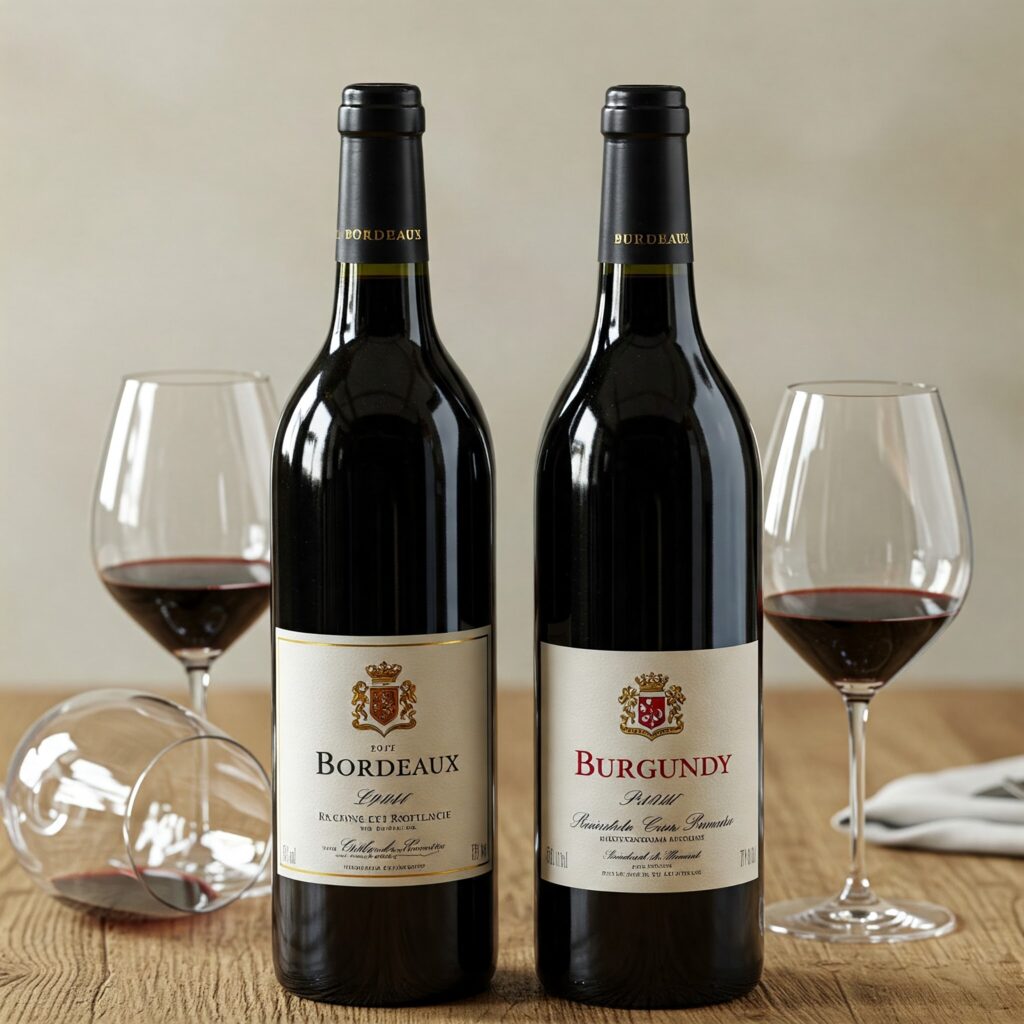
Burgundy vs Bordeaux wine: whats the difference?
When it comes to fine wine, few names evoke as much prestige and passion as Burgundy and Bordeaux. These two legendary French wine regions have shaped the world of viticulture for centuries, each carving out a distinctive identity that continues to captivate oenophiles around the globe. While both regions produce exceptional wines, their approaches to winemaking could not be more different—from the grapes they cultivate to the philosophies that guide their production.
Whether you're a seasoned collector or a curious newcomer to the world of fine wine, understanding the nuances between these iconic regions will enhance your appreciation and enjoyment of their liquid treasures. Join us as we uncork the fascinating distinctions that make Burgundy and Bordeaux unique yet equally compelling destinations for wine lovers.
The rivalry between Burgundy and Bordeaux spans centuries, with each region championing distinct approaches to winemaking. At their core, these differences can be summarized in a few essential contrasts:
Wine Philosophy: Burgundy celebrates terroir above all else, focusing on single vineyards and expressing the pure essence of place through predominantly single-varietal wines. Bordeaux, by contrast, embraces the art of blending multiple grape varieties to create balanced, complex wines that reflect both terroir and human craftsmanship.
Scale of Production: While Bordeaux operates on a grander scale with larger estates producing significant volumes, Burgundy consists of a patchwork of small family domains producing limited quantities of highly sought-after wines.
Wine Structure: Burgundian wines are known for their ethereal elegance, subtlety, and silky textures. Bordeaux wines typically offer more structure, power, and tannic backbone, designed for extended aging.
Classification Systems: Bordeaux follows a château-based classification system established in 1855 that ranks producers, while Burgundy's hierarchical system focuses on classifying specific vineyard plots based on their quality potential.
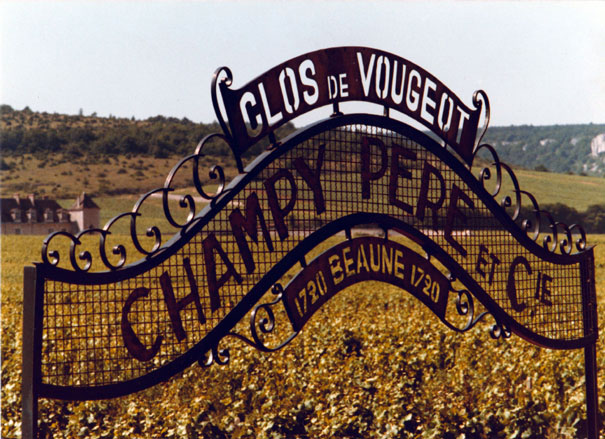
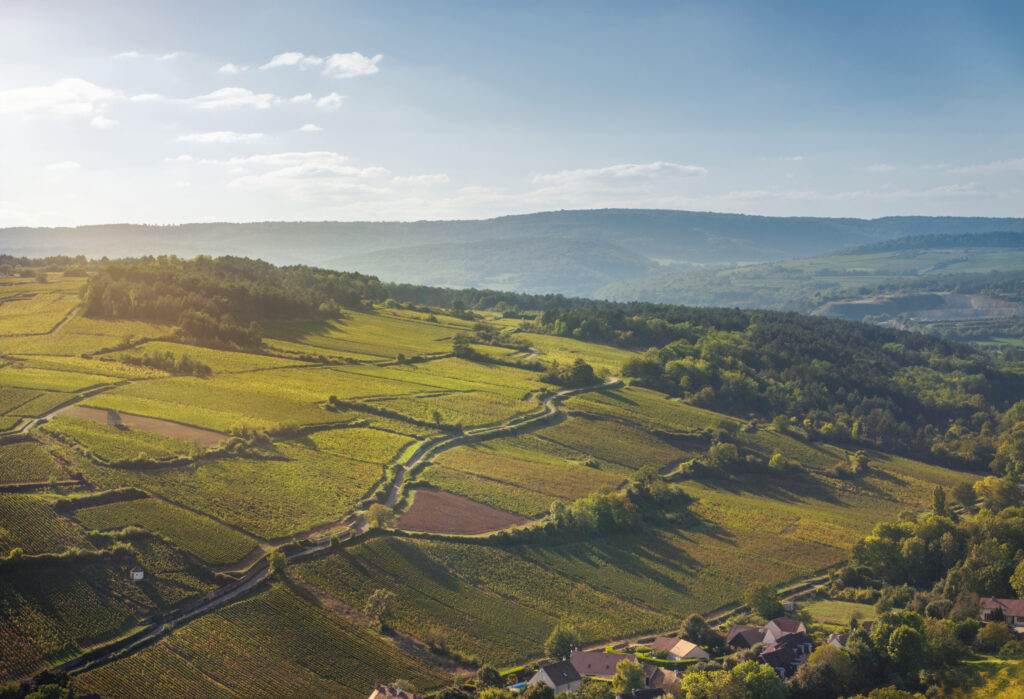
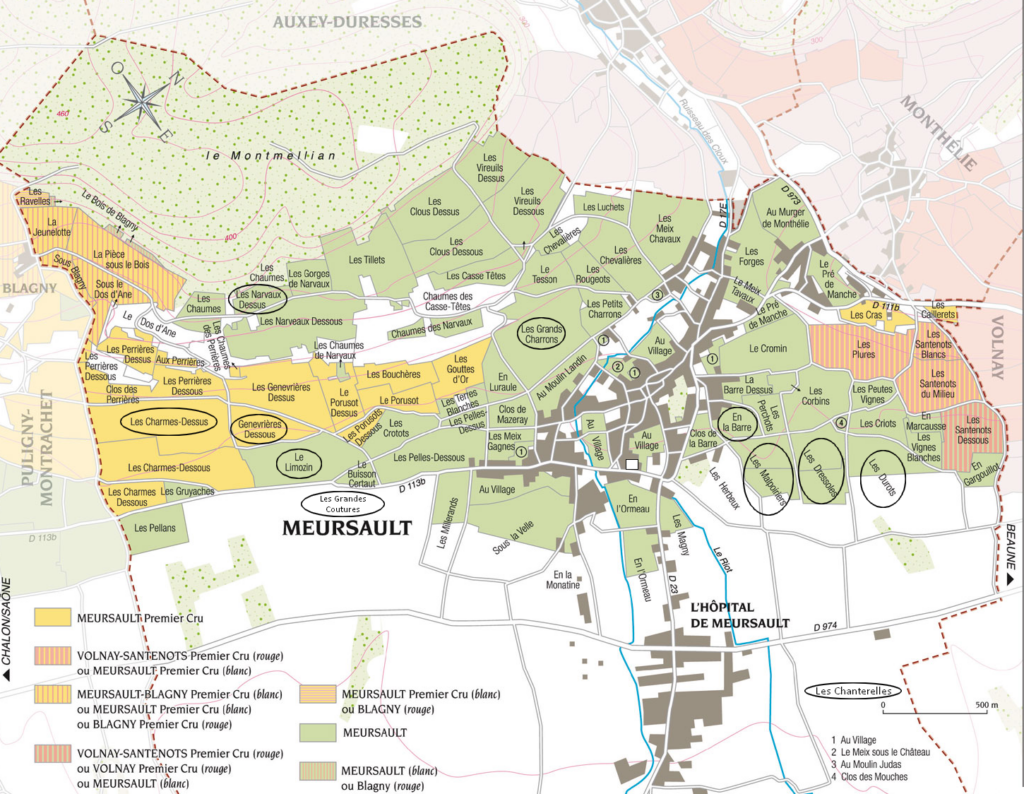
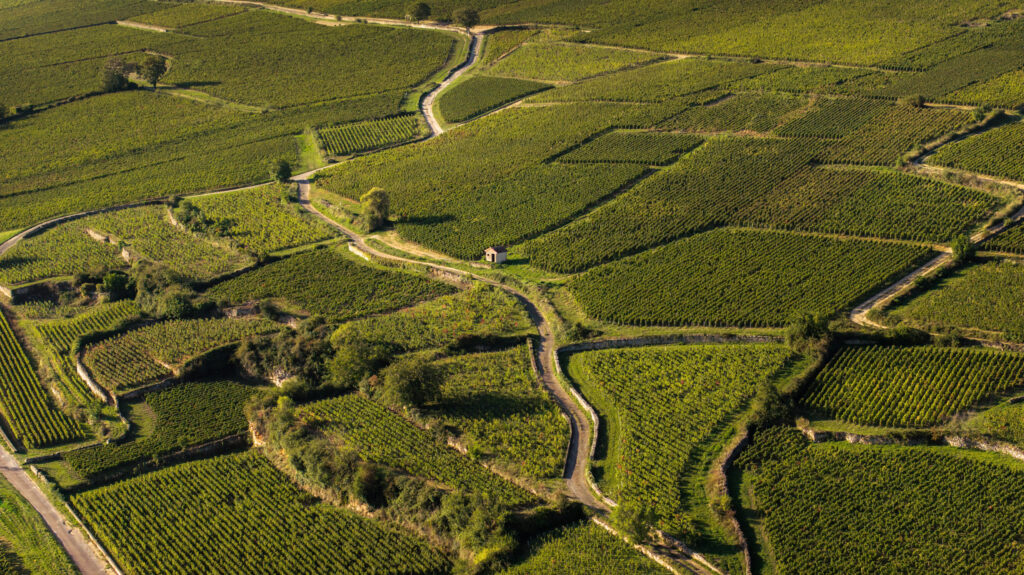
The concept of terroir—that magical combination of soil, climate, topography, and human influence—finds perhaps its purest expression in these two regions, albeit in dramatically different ways.
Burgundy's Terroir: Burgundy's narrow strip of vineyards along the eastern edge of France features a mosaic of microclimates and soil types, primarily limestone and clay in varying proportions. This incredible geological diversity can change dramatically within meters, explaining why adjacent vineyards often produce remarkably different wines. Burgundy's continental climate brings cold winters and warm summers, with spring frost presenting a constant threat to vine development.
The region's winemaking philosophy centers on allowing each tiny vineyard plot to express its distinctive character through minimal intervention. This meticulous focus on site-specificity has culminated in the identification of hundreds of individual climats (named vineyard sites), each with its own personality.
Bordeaux's Terroir: Spread across a much larger area in southwestern France, Bordeaux benefits from a maritime climate moderated by the Atlantic Ocean and the Gironde Estuary, which divides the region into Left Bank and Right Bank. The Left Bank features well-drained gravel soils perfect for Cabernet Sauvignon, while the Right Bank's clay and limestone soils favor Merlot.

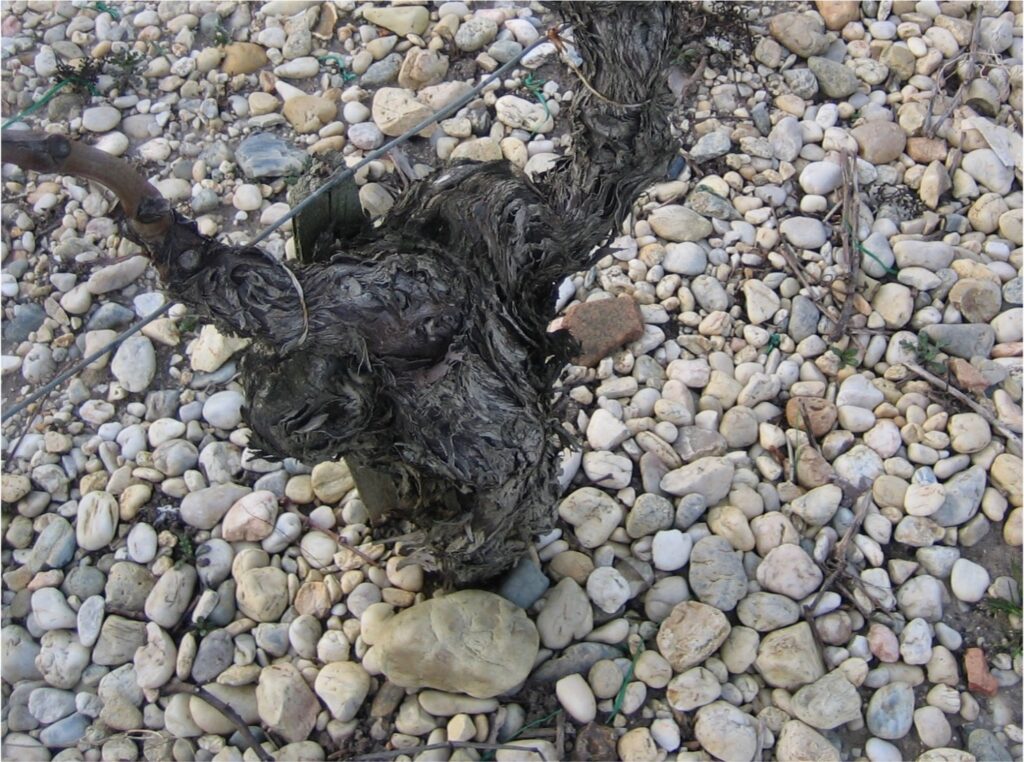
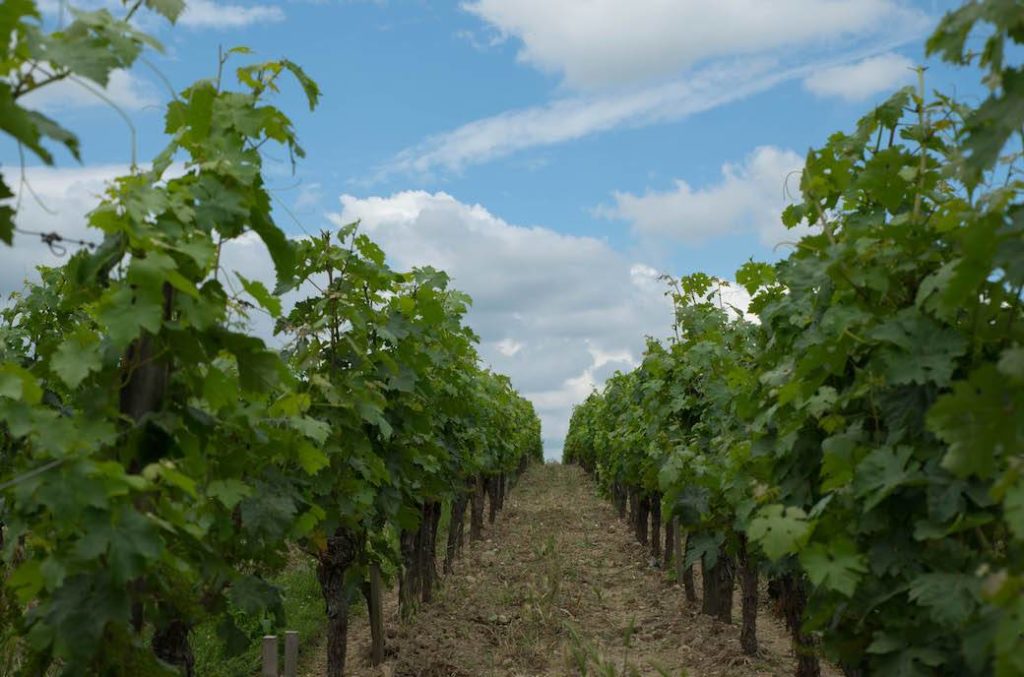
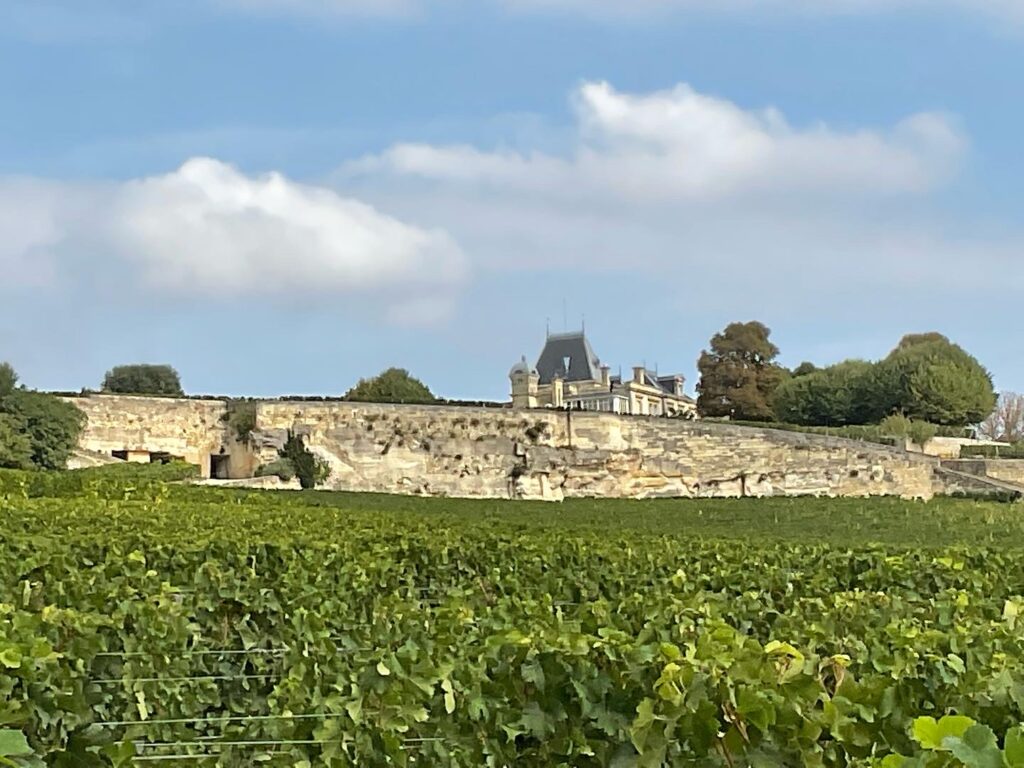
Rather than the extreme fragmentation seen in Burgundy, Bordeaux's terroir expression comes through larger appellations with more consistent characteristics. The region's château system, where estates control substantial vineyard holdings, allows for more consistent production levels and enables winemakers to craft balanced blends by selecting from various parcels.
Perhaps no contrast between these regions is more striking than their approach to grape varieties.
Burgundy's Grapes: Burgundy embraces radical simplicity, focusing almost exclusively on two grape varieties:
- Pinot Noir: The temperamental red grape that produces ethereal, silky wines with red fruit flavors, floral notes, and an ability to express terroir with unparalleled transparency.
- Chardonnay: The versatile white grape capable of producing everything from crisp, mineral-driven Chablis to rich, opulent wines from the Côte de Beaune.
This laser focus on two varieties allows Burgundian winemakers to become true specialists, dedicating generations to understanding how these grapes express each specific vineyard site.
Bordeaux's Grapes: Bordeaux thrives on the art of blending, primarily using five key varieties for red wines:
- Cabernet Sauvignon: Providing structure, tannin, and aging potential, particularly dominating Left Bank blends.
- Merlot: Contributing roundness, plushness, and accessibility, forming the backbone of Right Bank wines.
- Cabernet Franc: Adding aromatic complexity, finesse, and sometimes herbaceous notes.
- Petit Verdot: Bringing color, tannin, and spice notes in small proportions.
- Malbec: Historically important but now used sparingly for color and fruit.
For white wines, Bordeaux primarily uses:
- Sauvignon Blanc: Contributing freshness, acidity, and aromatic lift.
- Sémillon: Providing body, texture, and honeyed richness, especially in sweet Sauternes.
This diversity of grape varieties gives Bordeaux winemakers a broader palette from which to craft their wines, allowing them to adapt to vintage variations by adjusting their blends.
The contrast between these regions extends deeply into their production philosophies and structures.
Burgundy's production landscape reflects its historical fragmentation under Napoleonic inheritance laws, where vineyards were continually divided among heirs. Today, most Burgundian producers are small, family-owned operations, many farming just a few hectares spread across multiple vineyards. This small-scale approach necessitates hands-on viticulture and encourages meticulous attention to detail.
Production quantities are inherently limited, creating the scarcity that drives Burgundy's often astronomical prices. The winemaking typically emphasizes minimal intervention to preserve site expression, with judicious use of oak to complement rather than overpower the wine's natural character.
Bordeaux operates on a significantly larger scale, with estates often controlling dozens or even hundreds of hectares. The château system, where a single entity owns and manages substantial contiguous vineyards, allows for greater economies of scale and more consistent production volumes. Large, temperature-controlled cellars enable precise fermentation and aging, while dedicated sales teams manage global distribution networks.
This larger scale has historically made Bordeaux more accessible to consumers, though top-tier châteaux now command prices rivaling or exceeding Burgundy's finest offerings. The region's greater production capacity has also enabled it to establish a strong global presence, with Bordeaux often serving as many wine enthusiasts' introduction to fine French wine.
The classification systems employed by these regions reveal fundamentally different philosophies about what constitutes wine quality.
Bordeaux's Classification: Bordeaux's most famous classification system, established for the 1855 Paris Exhibition, ranked châteaux from the Médoc region into five growths or "crus" based primarily on their market prices and reputations at that time. This producer-based system essentially classified the estates themselves rather than specific vineyard sites. With few exceptions (most notably Château Mouton Rothschild's promotion to First Growth in 1973), this classification has remained largely unchanged for over 165 years.
Other Bordeaux sub-regions like Saint-Émilion have established their own classification systems with periodic revisions. These classifications have become powerful marketing tools that significantly influence wine pricing and global perception.
Burgundy's Classification: Burgundy's four-tiered hierarchy, formalized in the mid-20th century but based on centuries of observation, focuses entirely on specific vineyard sites rather than producers:
1. Grand Cru: The pinnacle of quality, representing just 2% of production from exceptionally situated vineyards.
2. Premier Cru: Outstanding vineyards comprising about 12% of production.
3. Village: Wines from specific communes, making up approximately 36% of production.
4. Regional: Basic wines from the broader Burgundy region.
This means that multiple producers can make wine from the same classified vineyard, with quality varying based on each winemaker's skill and approach. The emphasis remains firmly on the land itself rather than who owns it, reflecting Burgundy's belief that great wine begins with great terroir.
While both regions produce exceptional wines, their sensory profiles differ dramatically, offering wine lovers distinct pleasures.
Burgundian wines are often described as ethereal and sensual, prized for their aromatic complexity, silky textures, and ability to transmit terroir with remarkable transparency. Their moderate alcohol levels and balanced acidity make them exceptionally food-friendly and approachable in their youth, though the finest examples can age gracefully for decades.
Bordeaux wines, particularly from top châteaux, are typically more structured and powerful, with firm tannins that require time to soften. They often display greater uniformity within their appellations but can show tremendous complexity as they age, gradually revealing layers of secondary and tertiary aromas beyond their initial fruit-forward profiles.
Both regions produce wines with exceptional aging potential, though through different mechanisms. Burgundy's longevity stems from its perfect balance and concentrated fruit essence, while Bordeaux's ageability comes from its structured tannins and higher acidity.
Red Burgundy (Pinot Noir) offers an intoxicating aromatic profile that can include red cherries, wild strawberries, raspberries, and cranberries in youth, developing more complex notes of forest floor, mushrooms, game, and dried flowers with age. The mouthfeel is typically silky and refined, with bright acidity and fine-grained tannins that provide structure without aggressive grip.
Regional differences are pronounced, with Côte de Nuits generally producing more structured, powerful wines, and Côte de Beaune offering more aromatic, delicate expressions. Within these sub-regions, each village and vineyard imparts its distinctive character—Gevrey-Chambertin's wines tend toward muscularity and earthiness, while Chambolle-Musigny offers ethereal perfume and silky textures.
White Burgundy (Chardonnay) ranges dramatically in style from the steely, mineral-driven wines of Chablis to the rich, opulent expressions from Meursault and Puligny-Montrachet. Aroma profiles can include citrus fruits, green apples, and white flowers in cooler regions, trending toward riper stone fruits, honey, and hazelnut notes in warmer sites. Oak influence varies widely, from the unoaked purity of Chablis to the judicious barrel aging of Côte de Beaune whites.
The finest white Burgundies combine richness with precision, offering complex interplays between fruit intensity, mineral tension, and textural depth. As they age, they develop captivating notes of brioche, mushroom, and beeswax while maintaining vibrant acidity.
Red Bordeaux displays distinct characteristics depending on its bank of origin and blend composition. Left Bank wines, dominated by Cabernet Sauvignon, typically show firmer structure and notes of blackcurrant, cedar, graphite, and tobacco. Right Bank wines, led by Merlot, offer more immediate plushness with plum, chocolate, and truffle aromas.
Young Bordeaux often presents robust tannins and primary fruit flavors that require time to integrate and develop. With proper aging, these wines evolve magnificently, developing complex bouquets of leather, cigar box, dried fruits, and earthy undertones while maintaining remarkable freshness. The best examples can improve for decades, sometimes a century or more.
White Bordeaux, comprising primarily Sauvignon Blanc and Sémillon, can range from crisp, herbaceous styles to rich, honeyed expressions, particularly in sweet Sauternes. Dry whites offer citrus, gooseberry, and sometimes tropical fruit notes, often with subtle smokiness from oak aging. Sweet Bordeaux presents a luxurious profile of apricot, honey, marmalade, and botrytis-induced complexity.
Selecting between these two great regions often comes down to personal preference and the specific occasion:
Choose Burgundy if you:
- Appreciate subtlety, elegance, and nuance over power
- Enjoy wines that express a specific place with minimal winemaker intervention
- Prefer single-varietal wines that showcase the pure essence of Pinot Noir or Chardonnay
- Are seeking wines with silky textures and ethereal aromatics
Choose Bordeaux if you:
- Prefer more structured, powerful wines with firm tannins
- Appreciate the artistry of blending multiple grape varieties
- Enjoy wines that develop slowly and reward patience
- Are looking for more consistent styles within price categories
Of course, the true wine lover need not choose exclusively between these regions—each offers unique pleasures that complement rather than compete with one another.
Both regions produce exceptionally food-friendly wines, though their ideal pairings differ based on their inherent characteristics.
Burgundy's Food Affinities: The bright acidity and moderate tannins of red Burgundy make these wines remarkably versatile companions at the table. They pair beautifully with poultry (the classic coq au vin), game birds, mushroom dishes, and salmon. Their elegance complements rather than overwhelms delicate flavors.
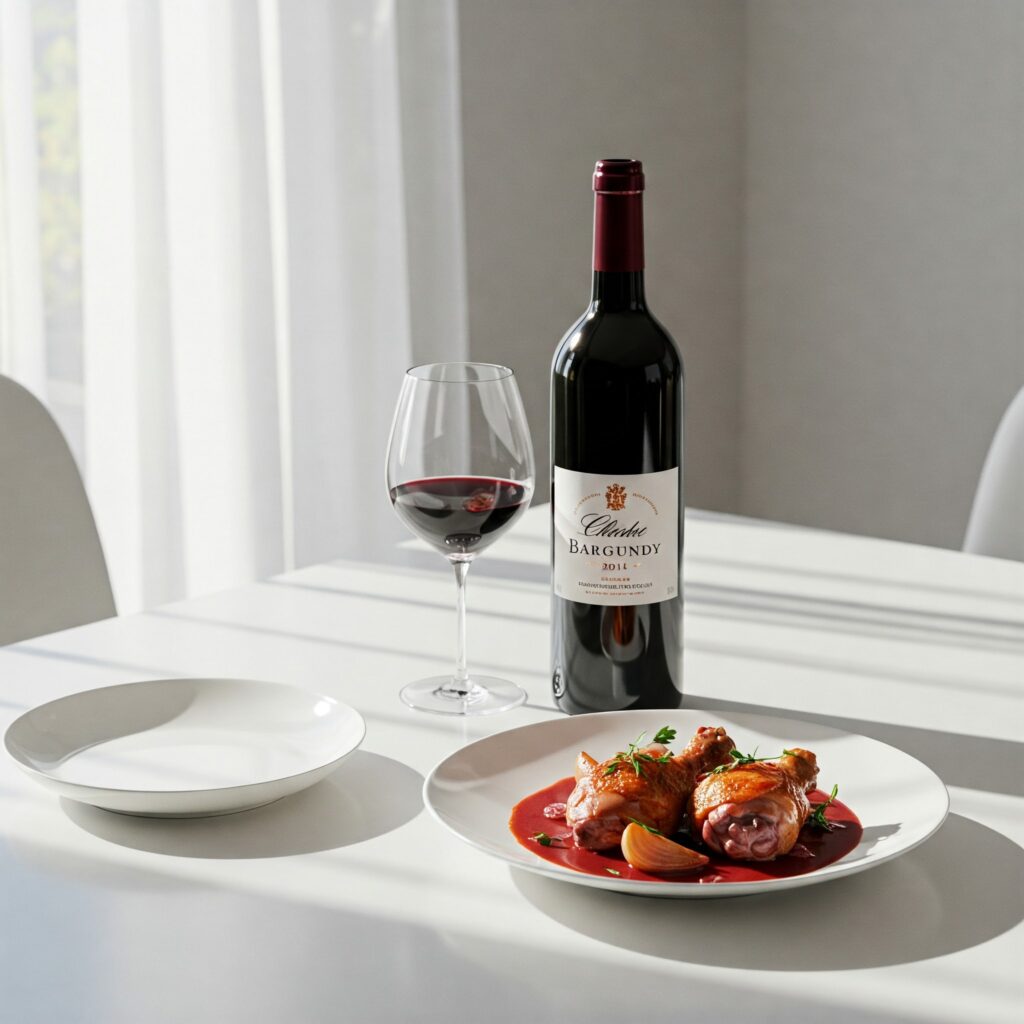
White Burgundy shines alongside seafood, from the classic pairing of Chablis with oysters to richer whites that complement lobster and creamy sauces. The wines' combination of acidity and body makes them ideal partners for a wide range of cuisines, from traditional French to modern Asian fusion.
Bordeaux's Food Affinities: Red Bordeaux's structure and robust tannins call for proteins and fats that can stand up to its powerful profile. Classic pairings include lamb, beef (particularly aged steaks), venison, and hard cheeses. The wines' firm structure helps cut through rich, fatty dishes.
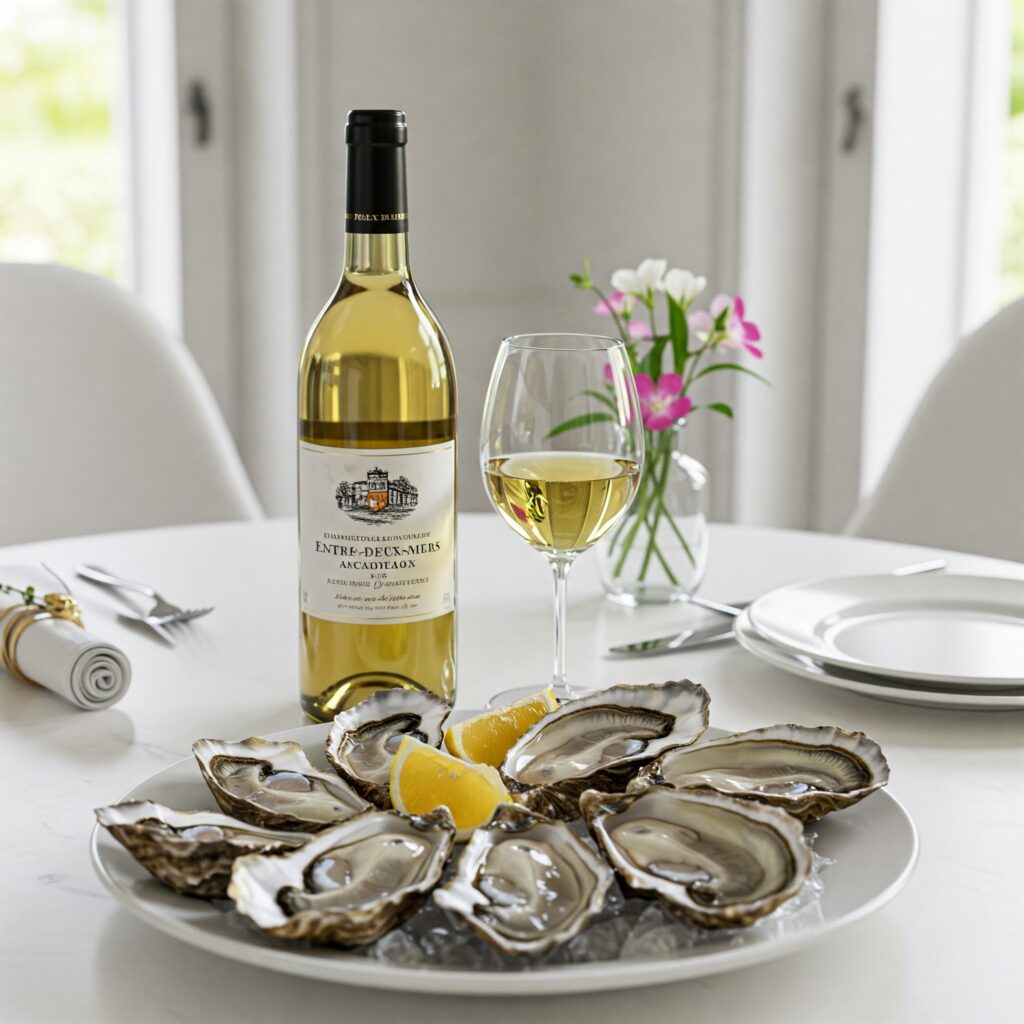
White Bordeaux pairs wonderfully with seafood, particularly when prepared with herbs or in butter sauces. Sweet Sauternes creates magical combinations with foie gras, blue cheeses like Roquefort, and fruit-based desserts. Keep it local with oysters coming from the bay of Arcachon and an crisp Entre-deux-Mers white wine.
Visiting these regions offers distinct yet equally rewarding experiences for the wine traveler, each reflecting the character of their wines and traditions.
Burgundy welcomes visitors with a tapestry of picturesque villages, ancient stone walls, and a palpable sense of history etched into the landscape. The region's charm lies in its intimate scale and refined aesthetic, with narrow country roads winding through the famous Côte d'Or ("Golden Slope") that houses some of the world's most coveted vineyard land.
A typical Burgundy visit centers around small, family-run domaines where tastings often take place in centuries-old cellars with the winemakers themselves. These boutique experiences offer rare insights into traditional winemaking methods and the meticulous attention to detail that defines Burgundian viticulture.
The medieval town of Beaune, with its iconic Hospices de Beaune and vibrant Saturday market, serves as the region's cultural heart. Nearby villages like Gevrey-Chambertin, Vosne-Romanée, and Puligny-Montrachet—names revered by wine lovers worldwide—invite leisurely exploration with their timeless stone buildings and surrounding vineyards.
Dining in Burgundy emphasizes local, seasonal ingredients prepared with classic techniques that highlight rather than overwhelm the region's refined wines. From casual bistros serving perfect coq au vin to Michelin-starred establishments offering contemporary interpretations of Burgundian cuisine, the food scene complements the wine culture perfectly.
Bordeaux offers a more majestic wine tourism experience, centered around impressive châteaux that dot the landscape like architectural jewels. These iconic estates, project the power and global influence that has defined Bordeaux for centuries.
Visits to premier Bordeaux estates often include tours of state-of-the-art winemaking facilities, historic barrel rooms, and carefully curated tasting experiences that showcase vertical vintages. The scale is grander, the presentation more polished, reflecting Bordeaux's long history of international trade and sophisticated marketing. Bordeaux has been receiving visitors far longer than Burgundy and their hospitality sections are well oiled machines today.
The city of Bordeaux itself has undergone a remarkable renaissance in recent decades, transforming from a somewhat sleepy port into a vibrant cultural destination. Its UNESCO-listed center features elegant 18th-century architecture, world-class museums, and a sophisticated dining scene that rivals Paris. The spectacular La Cité du Vin wine museum offers an immersive introduction to wine culture from around the world. With their state of the art tram system, getting around the town is simple. Bicycles can be rented and dropped off anywhere in town and walking around the center is a very safe option.
The surrounding wine regions, from the prestigious Médoc peninsula with its powerful Cabernet-based wines to the charming medieval town of Saint-Émilion with its limestone caves and cobblestone streets, provide diverse experiences for visitors. Each wine region takes a minimun of 45 minutes to an hour to reach from Bordeaux city center. Luxury accommodations, including châteaux-turned-hotels and bed and breakfasts, offer opulent bases for exploring this prestigious wine region.
At Decanter Tours, we understand that truly experiencing these legendary wine regions requires insider knowledge and exclusive access that goes beyond standard tourist routes. Our bespoke wine journeys in Burgundy and Bordeaux are crafted to reveal the soul of these regions through immersive, authentic experiences.

Our deep-rooted relationships with prestigious domains and châteaux open doors typically closed to the public, allowing our guests to taste rare vintages and meet the visionaries behind the wines. In Burgundy, this might mean a private tasting with a fifth-generation winemaker in their family cellar or a private wine and war focused visit: explore the historic cellars connected to the Hospices de Beaune via secret tunnels, once used by owners seeking refuge during WWII.
In Bordeaux, we provide unprecedented access to classified growth châteaux, including behind-the-scenes tours of their state-of-the-art facilities and vertical tastings of exceptional vintages, wine and food pairings and comparative tastings. Our expertly guided explorations of both regions balance iconic estates with hidden gems, ensuring a comprehensive understanding of each region's unique character.
Decanter Tours' luxury experiences extend beyond wine to encompass the finest regional gastronomy, from intimate dinners at Michelin-starred restaurants to cooking classes with celebrated local chefs. Our carefully selected accommodations—whether boutique hotels in historic Beaune or luxurious château stays in Bordeaux—provide the perfect complement to days spent exploring vineyards.
Most importantly, our knowledgeable guides bring these experiences to life with contextual insights that deepen your appreciation of every wine you taste and every landscape you traverse. Whether you're a seasoned collector or an enthusiastic newcomer, Decanter Tours crafts journeys that will forever enhance your understanding and enjoyment of these incomparable wine regions.
Contact us today for your Bordeaux to Burgundy experience.
This age-old debate has no definitive answer, as "better" depends entirely on personal preference. Burgundy produces ethereal, terroir-expressive Pinot Noir wines valued for their aromatic complexity and silky textures. Bordeaux creates more structured, powerful blends (primarily Cabernet Sauvignon and Merlot) prized for their aging potential and consistent quality. Rather than declaring one superior, wine enthusiasts should explore both regions to discover which style resonates more with their individual palate.
While both regions produce wines across various price points, Burgundy's top wines have generally reached higher price levels in recent years due to extremely limited production and growing global demand. The fragmented nature of Burgundy's vineyards, where top producers might make just a few barrels of their finest wines, creates scarcity that drives prices upward. Bordeaux produces larger quantities, even of its most prestigious wines, though First Growth Bordeaux and other top châteaux still command very significant prices. For everyday drinking, both regions offer excellent options at more accessible price points through lesser-known producers and entry-level appellations.
While geographically separated by about 500 kilometers (310 miles), it is certainly possible to experience both Burgundy and Bordeaux in a single trip with proper planning. A high-speed train connects Paris to Dijon (Burgundy) in about 1.5 hours and Paris to Bordeaux in about 2 hours. Alternatively, a direct flight from Lyon (near Burgundy) to Bordeaux takes approximately one hour. Decanter Tours specializes in creating seamless multi-region itineraries that maximize your time in the vineyards rather than in transit, allowing you to compare and contrast these iconic wine destinations in a single luxurious journey. We recommend allowing at least three days in each region to truly absorb their distinctive characters and experience their diverse appellations.
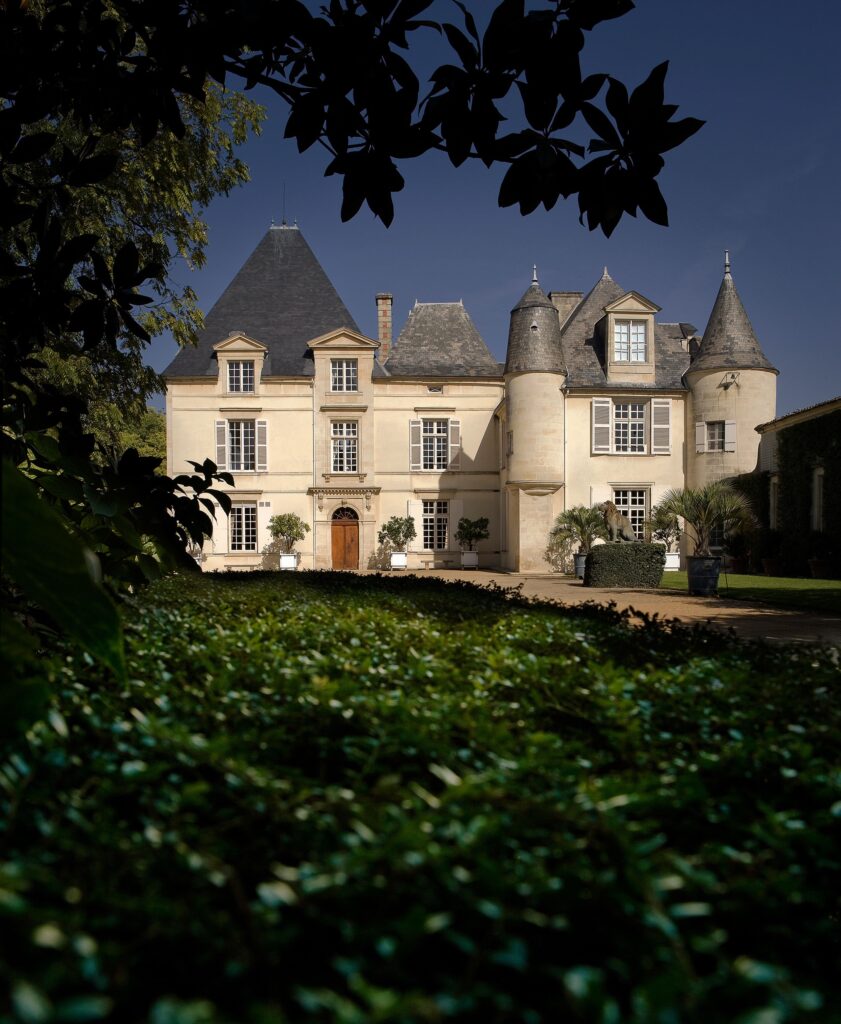
In the world of fine wines, few classifications hold the prestige and historical significance of the Grand Cru Classé de Graves. This elite designation represents the pinnacle of winemaking excellence in Bordeaux's Graves region, encompassing 16 exceptional châteaux renowned for their outstanding terroir and winemaking traditions. Whether you're a seasoned wine connoisseur or an enthusiastic beginner, understanding this classification unlocks a deeper appreciation for some of Bordeaux's most distinguished wines.
The Grand Cru Classé de Graves represents an exclusive classification system that recognizes the most prestigious wine estates within the Graves region of Bordeaux. Unlike other Bordeaux classifications that focus solely on red or white wines, the Grand Cru Classé de Graves stands unique in acknowledging excellence in both varieties from the same estates.
This classification serves as a mark of exceptional quality, rigorous production standards, and consistent excellence. For wine enthusiasts, the Grand Cru Classé designation signals wines of remarkable character, complexity, and aging potential that embody the distinctive gravelly terroir from which they derive their name.
The classification's origins trace back to 1953 when it was first established, then subsequently revised in 1959 to its current form. This makes it considerably younger than the famous 1855 Bordeaux Classification that governs Médoc and Sauternes. While the 1855 classification resulted from Napoleon III's request for a ranking system for the Paris Exhibition, the Grand Cru Classé de Graves emerged from regional efforts to distinguish the exceptional estates within this historically significant winemaking area.
What sets this classification apart is its foundation in the post-World War II era, allowing it to incorporate more modern winemaking philosophies while still honoring traditional methods. The classification has remained unchanged since 1959, creating a stable legacy that continues to influence Bordeaux's wine industry today.
Achieving Grand Cru Classé de Graves status requires meeting exacting standards across multiple dimensions:
These stringent requirements ensure that only truly exceptional estates earn and maintain this prestigious classification, creating an assurance of quality for wine consumers worldwide.
The Grand Cru Classé de Graves classification encompasses exactly 16 châteaux, making it one of the most exclusive wine designations in the world. This limited membership underscores the exceptional quality required for inclusion and highlights the rarity of these distinguished wines.
What makes this classification particularly unique in Bordeaux is its recognition of both red and white wines from the same estates. While some châteaux excel primarily in one category, many produce outstanding examples of both, showcasing the versatility and excellence of the Graves terroir.
The Grand Cru Classé de Graves stands as the only Bordeaux classification that formally recognizes excellence in both red and white wine production. This dual categorization reflects the region's exceptional ability to produce world-class wines across different styles:
Red Wines: All 16 classified châteaux produce red wines, typically blends dominated by Cabernet Sauvignon and Merlot, with smaller proportions of Cabernet Franc and Petit Verdot. These reds are known for their structure, elegance, and remarkable aging potential.
White Wines: Several of the classified châteaux also produce exceptional white wines, primarily from Sauvignon Blanc and Sémillon grapes. These whites are celebrated for their complexity, mineral character, and ability to develop beautifully with age – a characteristic that sets them apart from many white wines worldwide.
This dual classification system highlights the Graves region's unique diversity and versatility in winemaking, offering enthusiasts a comprehensive experience of Bordeaux's finest expressions. However there are no individual rankings (first, second, third classified growth etc.) like for the 1855 classification of the Graves and Sauternes.

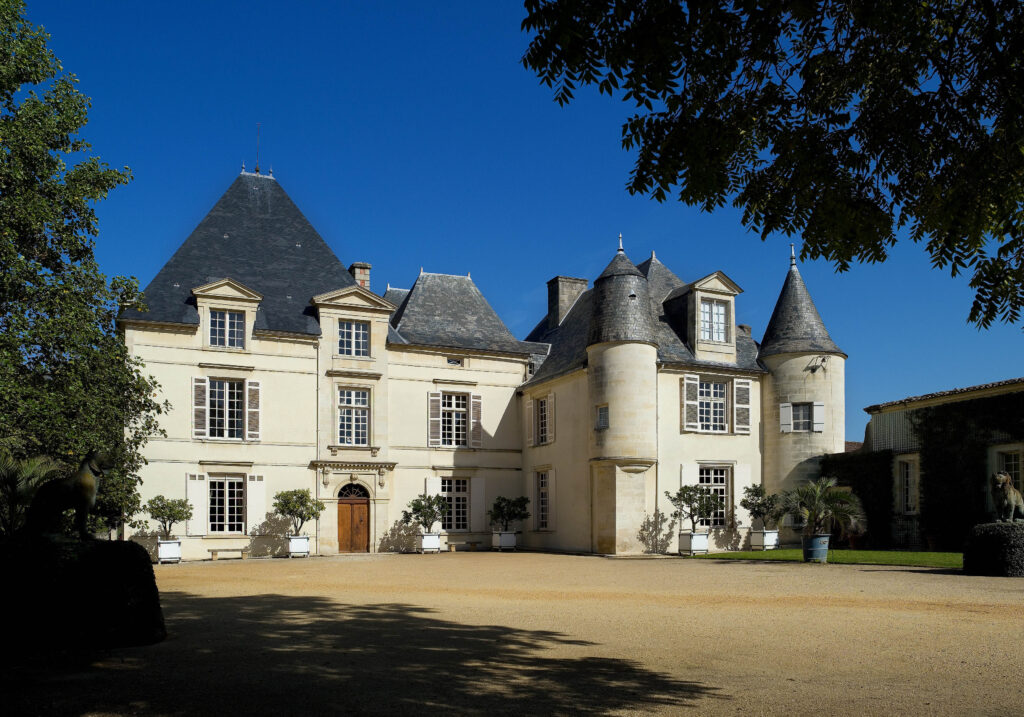
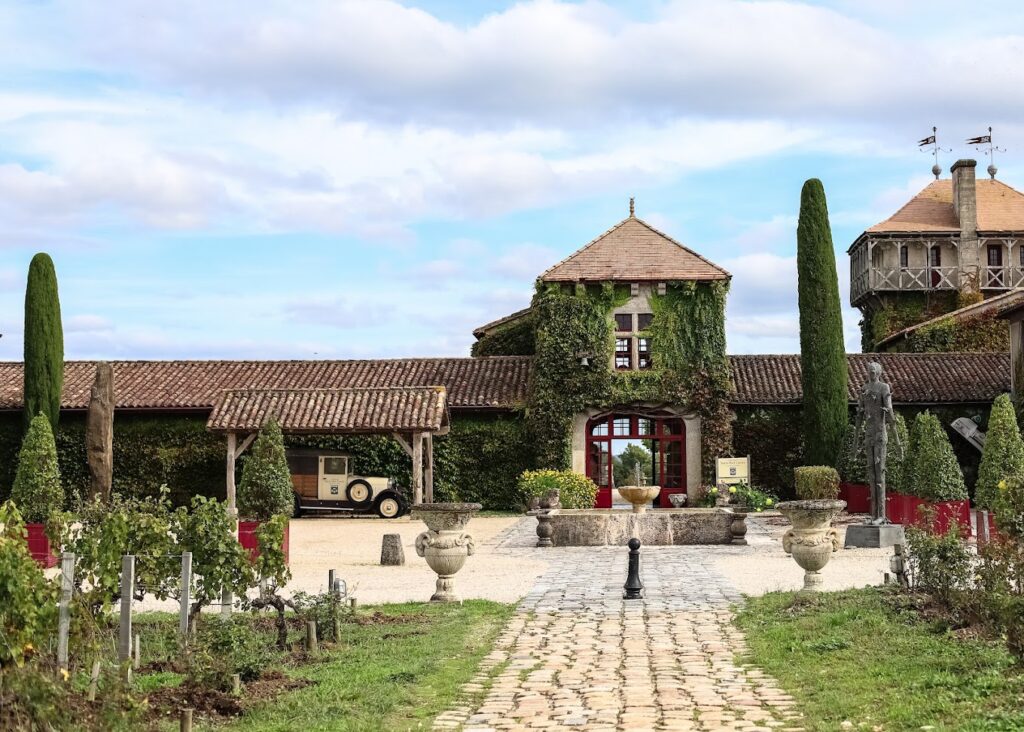
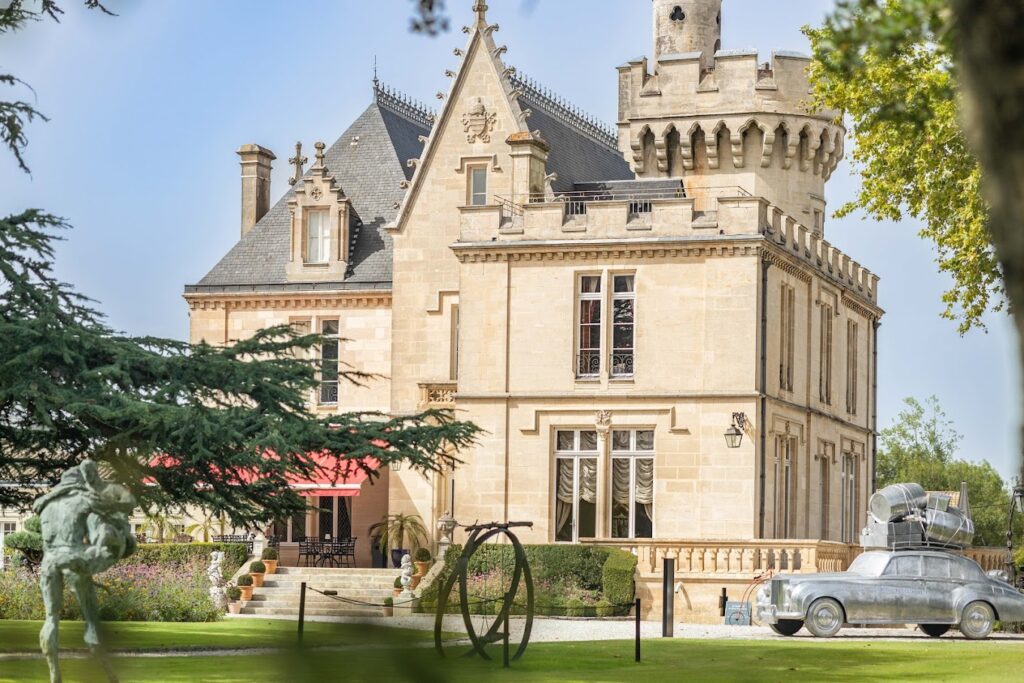
The 16 esteemed châteaux that comprise the Grand Cru Classé de Graves represent the pinnacle of winemaking excellence in this historic region. Each estate brings its own distinctive character and approach to winemaking while upholding the rigorous standards of the classification. Here are just a few we visit regularly.
Château Haut-Brion stands as the undisputed crown jewel of the Graves classification. As the only Graves estate also included in the prestigious 1855 Classification (as a First Growth), it holds a dual distinction that speaks to its extraordinary quality and historical importance.
Dating back to the 16th century, Haut-Brion pioneered many modern winemaking techniques and has maintained its reputation for producing wines of remarkable finesse, complexity, and aging potential. Its red wines offer an elegant profile with notes of dark fruits, tobacco, and an unmistakable gravelly minerality, while its white wines (Haut-Brion Blanc) are among the most sought-after and expensive white wines in the world.
The château's consistent excellence through centuries of production has cemented its status as not just a leader in Graves, but as one of the world's most iconic wine estates.
Located directly across from Château Haut-Brion and now under the same ownership, Château La Mission Haut-Brion has carved out its own distinguished reputation. Often considered the equal of its illustrious neighbor, La Mission produces red wines characterized by power, depth, and remarkable complexity.
The château's red wines typically show greater boldness and concentration than Haut-Brion, with prominent notes of black fruits, smoke, and earth. Its white wine, La Mission Haut-Brion Blanc, rivals its red counterpart in quality and prestige, offering rich textures with honeyed notes balanced by vibrant acidity.
The estate's winemaking philosophy embraces both tradition and innovation, resulting in wines that consistently rank among the finest in Bordeaux and showcase the exceptional potential of the Graves terroir.
Decanter Tours' Tip: Chateau La Mission Haut-Brion is more accessible than Chateau Haut Brion. Both are great to see but we love the gardens at La Mission.
Named after its most famous owner, Pope Clement V, Château Pape Clément boasts one of the longest histories of any Bordeaux wine estate, dating back to the 13th century. This venerable château has distinguished itself through a careful balance of respecting tradition while embracing modern innovations.
Under the stewardship of the well-known Bordeaux wine producer, Bernard Magrez, Pape Clément has implemented cutting-edge viticultural practices, including plot-by-plot harvesting and precision viticulture. The red wines are known for their opulence, concentration, and rich dark fruit profiles, while the whites offer aromatic complexity and remarkable texture.
The chateau is located within the outer ring road of Bordeaux town which makes it one of the few urban wineries that can be found in the area.
Over the past few decades, Château Smith Haut Lafitte has undergone a remarkable transformation under the ownership of Daniel and Florence Cathiard. This revitalization has elevated the estate to new heights while maintaining deep respect for its historical significance.
The château has embraced organic and biodynamic and sustainable principles, establishing its own cooperage and implementing innovative techniques such as using optical sorting technology and gravity-flow systems. These investments in quality have yielded exceptional results. They built their ‘Stealth Cellar’ in 2013 to for grapes from younger vines destined for the second wines of the property; Le Petit Haut Lafitte and Les Hauts de Smith. It was designed to minimise its environmental impact and was built around existing trees, with the moss and shrubs growing on the roof to blend into the environment and increase insulation. The thick walls are built from local materials by local builders and the natural humidity and geothermal heat exchangers maintain cool temperatures. Solar panels help power the cellar and since 2014, CO2 from fermentation is recovered to make bicarbonate of soda
Smith Haut Lafitte's red wines display impressive depth and structure with signature notes of blackberry, truffle, and graphite, while their whites are consistently rated among Bordeaux's finest, offering vibrant citrus notes with distinctive minerality and complexity.
The estate exemplifies how thoughtful modernization can enhance traditional winemaking, resulting in wines that honor their heritage while appealing to contemporary wine enthusiasts.
Decanter Tours' Tip: their Foret des Sens is well worth a stroll on a summers day. This new ‘Land Art’ installation – The Forest of the Five senses is hidden away in almost 20 acres of woods behind Château Smith Haut Lafitte.
The exceptional quality of Grand Cru Classé de Graves wines stems from a perfect alignment of natural advantages and human expertise. These wines capture the essence of their unique terroir while demonstrating the skillful hand of generations of winemakers.
Several factors contribute to their special character:
These combined elements create wines that transcend simple beverage status to become expressions of place, time, and human artistry.
The red wines from Grand Cru Classé de Graves estates showcase a distinctive personality that sets them apart from other Bordeaux appellations. While sharing the region's commitment to excellence, these wines express unique characteristics:
The best examples demonstrate remarkable longevity, with premium vintages continuing to evolve and improve for 30+ years, making them treasured additions to serious wine collections.
The white wines of Grand Cru Classé de Graves stand among the world's most distinctive and age-worthy white wines, challenging the notion that only red wines deserve serious cellaring. These exceptional whites offer a compelling combination of immediate pleasure and long-term potential:
These whites represent some of Bordeaux's most sought-after and expensive white wines, competing with the finest white Burgundies for complexity and aging potential.
The Grand Cru Classé de Graves holds a unique position among Bordeaux's classification systems, with several distinguishing characteristics that set it apart:
Dual Wine Recognition: Unlike the 1855 Classification, which separately classifies Médoc reds and Sauternes whites, the Graves classification recognizes excellence in both red and white wines from the same estates.
Geographic Focus: The classification is exclusively limited to the historic Graves region, focusing on terroir-specific excellence rather than the broader approach of some other classifications.
Historical Context: Established in 1953 and finalized in 1959, it's considerably younger than the 1855 Classification, reflecting post-war quality assessments rather than 19th-century market values.
Static Nature: Like the 1855 Classification, the Grand Cru Classé de Graves has remained unchanged since its establishment, unlike the Saint-Émilion classification which undergoes regular revision.
Qualitative Foundation: The classification was based primarily on wine quality and estate reputation rather than market prices, which heavily influenced the 1855 Classification.
These differences highlight the unique approach and standards of the Grand Cru Classé de Graves, offering wine enthusiasts a different lens through which to appreciate Bordeaux's diverse wine traditions.
Experiencing the magic of Grand Cru Classé de Graves wines in their native setting offers an unparalleled opportunity to understand their true character and heritage. Decanter Tours provides exclusive access to these prestigious estates through carefully curated luxury experiences.
Our specialized Graves tours feature:
Our customizable itineraries can focus exclusively on Grand Cru Classé properties or incorporate them into broader Bordeaux explorations. Transportation is provided in luxury vehicles, and accommodations feature the finest hotels in the region, ensuring your experience matches the prestige of the wines themselves.
Whether you're a serious collector seeking to deepen your knowledge or a wine enthusiast looking to understand what makes these wines so special, a Decanter Tour provides the ultimate way to experience the Grand Cru Classé de Graves.
The Grand Cru Classé de Graves is an official wine classification that recognizes 16 exceptional wine estates in the Graves region of Bordeaux, France. Established in 1953 and finalized in 1959, it distinguishes châteaux that produce wines of outstanding quality, character, and consistency. This prestigious classification is unique in Bordeaux for recognizing both red and white wines from the same estates, highlighting the region's versatility and excellence across different wine styles.
Achieving Grand Cru Classé de Graves status requires meeting stringent criteria across multiple dimensions. Estates must demonstrate exceptional terroir with the characteristic gravelly soils that give the region its name. They must show historical consistency in producing outstanding wines over generations. Their production methods must adhere to the highest standards from vineyard management through winemaking. The wines themselves must display exceptional quality, complexity, and aging potential. Finally, the château must maintain an excellent reputation among wine professionals, critics, and collectors. As the classification has remained unchanged since 1959, these standards represent a historical assessment rather than an ongoing review process.
Exactly 16 châteaux hold the prestigious Grand Cru Classé de Graves designation. This limited number underscores the exclusivity and high standards required for inclusion. The classified estates include some of Bordeaux's most famous names, such as Château Haut-Brion (which is also a First Growth in the 1855 Classification), Château La Mission Haut-Brion, Château Pape Clément, and Château Smith Haut Lafitte. All 16 estates produce classified red wines, while several also produce exceptional white wines that carry the classification, making it unique among Bordeaux's classification systems for recognizing both wine styles.
Yes, many Grand Cru Classé de Graves châteaux welcome visitors, though typically by appointment only. These estates offer various visiting experiences, from standard tours and tastings to more exclusive private experiences. The level of access varies by château, with some offering intimate tastings with winemakers or owners, while others provide structured group experiences. For the most comprehensive and privileged access, specialized wine tour companies like Decanter Tours can arrange VIP visits that include private tastings of library vintages, meetings with château principals, and behind-the-scenes access not available to the general public. Visiting during harvest season (September-October) provides unique insights into the winemaking process, though availability may be more limited as estates focus on production.
Imagine rolling hills blanketed with vineyards, the Garonne River glistening in the distance, and the distinct crunch of gravel beneath your feet. This isn't a dream; it's Graves, the cradle of Bordeaux wine, a region where history and terroir intertwine to create wines of exceptional character and a travel experience that resonates with every wine lover. More than just a geographical location, Graves is a narrative, a story told through its wines, its landscapes, and its people.
Graves, a historic and geographically significant region within Bordeaux, France, offers a captivating blend of rich winemaking tradition and stunning landscapes. This region, the birthplace of Bordeaux wines, invites you to explore its vineyards, delve into its fascinating past, and savor its distinctive wines. From its unique terroir to its charming towns, Graves promises an unforgettable experience for wine lovers and history buffs alike.
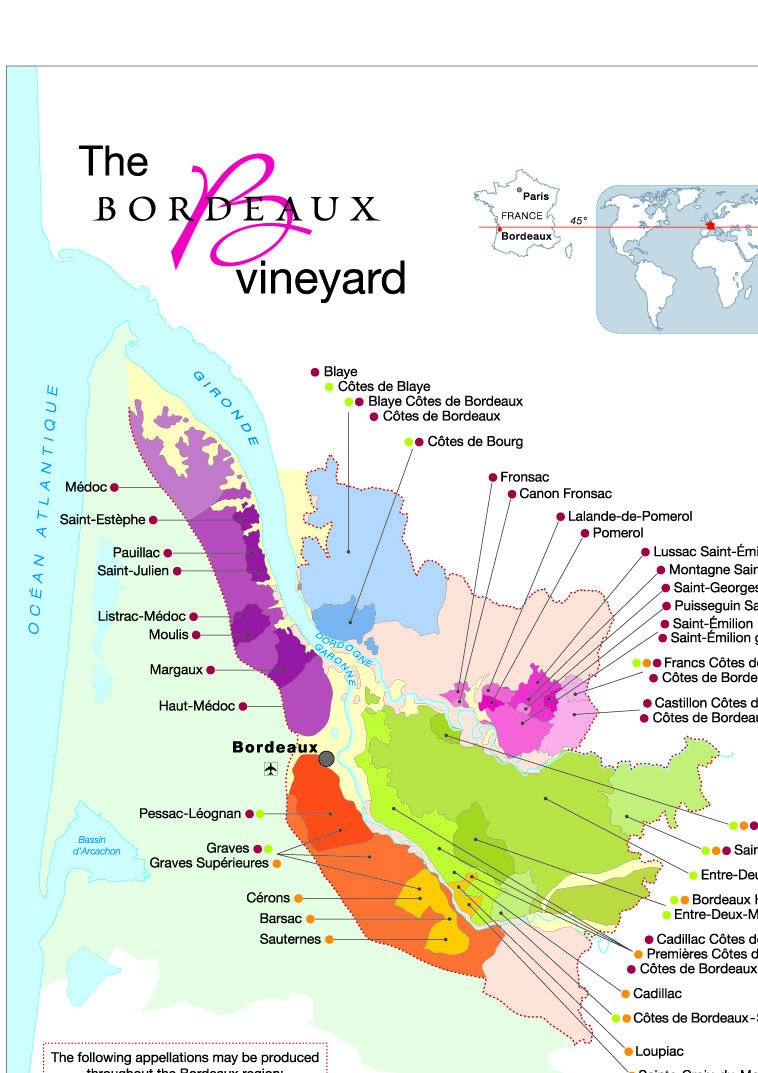
Graves isn't just in Bordeaux; it's where the Bordeaux story began. Situated south of the city of Bordeaux, on the left bank of the Garonne River, Graves holds a unique position in the region's viticultural landscape. The Garonne, a vital artery for the region, moderates the climate and has played a crucial role in shaping the terroir for centuries. Its proximity to Bordeaux makes it easily accessible for visitors, yet Graves retains a distinct identity, a connection to the origins of Bordeaux winemaking that you won't find anywhere else. Think of it as the ancestral home of Bordeaux wine, where the traditions and techniques that made the region famous were first established.
What truly sets Graves apart is its remarkable geological diversity. The name itself, "Graves," is a direct reference to the region's defining characteristic: its gravelly soil. But it's not simply "gravel"; it's a complex mosaic of different types of gravel – from small, rounded pebbles to larger, more angular stones – interspersed with clay, sand, and limestone deposits. These gravelly soils, sometimes reaching depths of 12 meters or more, act as a natural drainage system, preventing waterlogging and forcing vine roots to delve deep, sometimes over 20 meters, into the earth in search of nourishment. This "struggle" for survival results in lower yields, but it also concentrates the flavors in the grapes, leading to wines of exceptional complexity, structure, and aging potential. Imagine the vines as artists, sculpting their masterpieces from the very earth they inhabit.
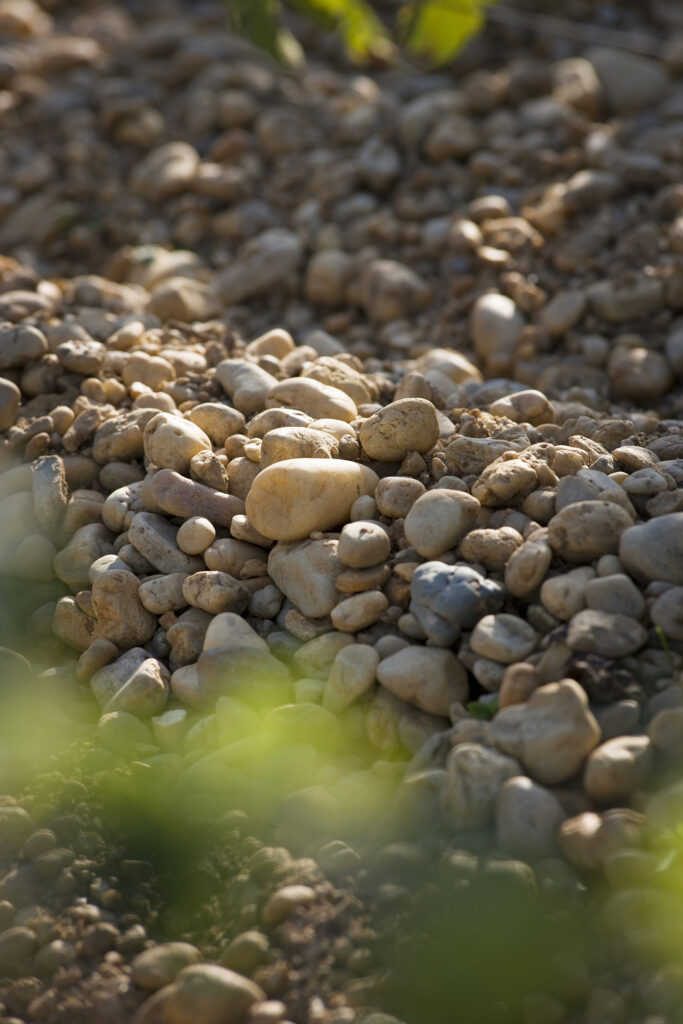
The Garonne River plays a crucial role in this geological drama. It not only moderates the climate, creating beneficial microclimates, but also influences the soil composition through erosion and deposition. The river's presence, combined with the diverse soils and the temperate oceanic climate, creates a unique terroir that is the foundation of Graves' distinctive wines. The climate, with its mild temperatures, ample rainfall, and long, sun-drenched summers, allows the grapes to ripen slowly and evenly, developing complex aromas and flavors. It's a delicate balance of nature's elements, a perfect harmony that allows Graves to produce wines of such exceptional quality.
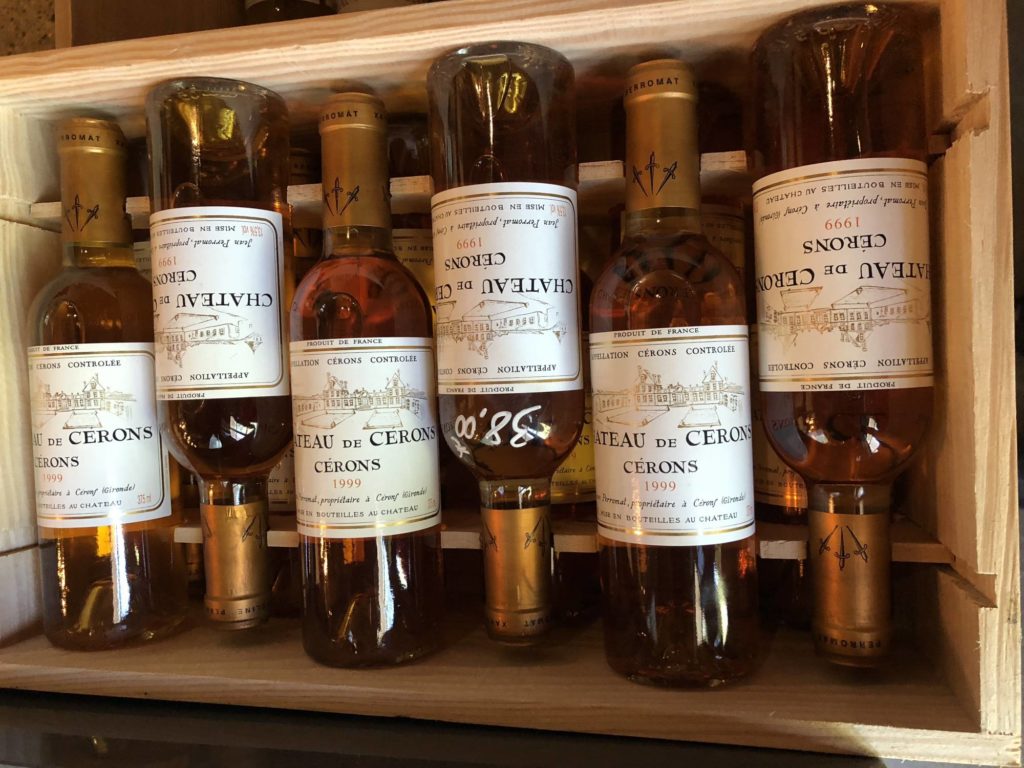
The gravel-rich soils of Graves are more than just a geological feature; they are the key to understanding the region's wine quality. The excellent drainage provided by the gravel prevents waterlogging, which can dilute flavors and promote fungal diseases. This allows the vines to thrive and develop deep, extensive root systems, accessing deeper water reserves and a wider range of minerals. This, in turn, translates into more concentrated flavors, richer aromas, and a greater depth of character in the wines. The gravel also acts as a natural heat reflector, radiating warmth back onto the grapes and aiding in ripening, contributing to the development of phenolic compounds, which are essential for color, tannins, and aging potential. These well-drained soils, combined with the other geological components, contribute significantly to the remarkable aging potential of Graves wines, allowing them to evolve and develop beautifully over decades.
Graves doesn't just produce wine; it embodies a history that stretches back to Roman times. The Romans, recognizing the region's potential for viticulture, planted the first vines, laying the foundation for what would become one of the world's most prestigious wine regions. Graves played a crucial role in establishing Bordeaux as a major wine capital. During the Middle Ages, the wines of Graves, particularly its claret (red Bordeaux), were highly prized in England. The export of Graves wines to England, beginning as early as the 12th century, had a profound impact on the development of the Bordeaux wine trade, shaping its reputation for quality and prestige. It was the wines of Graves that first commanded high prices and established Bordeaux's reputation for fine wine. From the 15th to the 18th centuries the Graves was known for its excellent wines and had a high level of exports. The very name "Graves," derived from the gravelly soil ("graves" in French), is a testament to the region's defining characteristic and its enduring legacy.
Graves wasn't just part of the Bordeaux wine trade; it launched it. Its wines, particularly the red wines, were highly sought after, especially by the English market which started from the 12th century. This demand fueled the growth of the Bordeaux wine industry and cemented Graves' position as a key player. The region's success in exporting its wines, often through the bustling port of Bordeaux, laid the groundwork for the wider Bordeaux wine trade to flourish, solidifying its position as a leading wine region. Graves' influence can still be tasted in every bottle of Bordeaux, a testament to its pioneering spirit.
Graves offers more than just exceptional wines; it offers a journey into the heart of French culture and history. Explore the region's rich heritage by visiting historical landmarks, including ancient churches, majestic castles (chateaux), and impressive monuments. The Château de la Brède, the birthplace of Montesquieu, the renowned political philosopher, is a must-see for history enthusiasts. Indulge in the region's gastronomy, savoring traditional French cuisine that perfectly complements the local wines. From hearty dishes like entrecôte bordelaise (steak with Bordeaux sauce) to delicate seafood from the nearby coast, Graves offers a culinary adventure as rich and diverse as its wines. The charming towns and villages of Graves, such as Léognan, Barsac, and Sauternes, each with their own unique character and charm, offer a glimpse into authentic French life and provide a welcome escape from the hustle and bustle of modern life.
Graves is an ideal destination for wine lovers seeking an authentic and immersive experience. The region's scenic beauty, tranquil atmosphere, and welcoming chateaux create a charming setting for vineyard visits and wine tastings. Explore the local touristic routes, such as the Graves Wine Route, and discover hidden gems among the vineyards. The accessibility of the vineyards allows for intimate and informative tours, providing a deeper understanding of the winemaking process and the unique terroir of Graves. Many chateaux offer tours and tastings, allowing visitors to experience the hospitality and passion of the winemakers firsthand. It's an opportunity to connect with the people who craft these exceptional wines and to appreciate the dedication and artistry that goes into every bottle.
Beyond wine tours, Graves offers a wealth of activities to enrich your visit, catering to a variety of interests. Hike or bike through the picturesque countryside, immersing yourself in the natural beauty of the region. For a different perspective on the landscape, consider kayaking or canoeing down the Cérons River. This gentle river meanders through the heart of the Graves region, offering a tranquil and scenic way to experience the natural beauty of the area, passing by vineyards and charming villages along the way.
Visit local markets to discover regional products, from fresh produce to artisanal cheeses, and interact with local producers. Leognan has a Saturday morning market and La Breda on Wednesdays. Explore the small towns and villages, each with its own unique charm and history. Engage with the local culture and experience the authentic French lifestyle. Consider taking a cooking class focused on regional cuisine or visiting a local artisan workshop to delve deeper into the traditions and crafts of Graves.
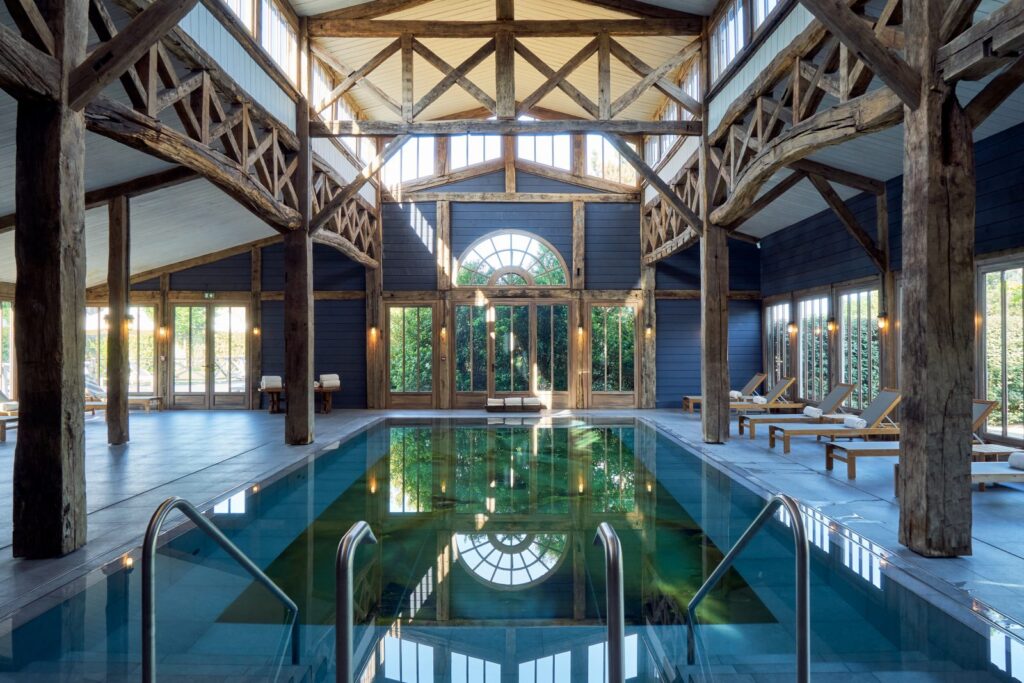
For those seeking relaxation and rejuvenation after a day of exploring, a spa day at Les Sources de Caudalie is an absolute must. This luxurious spa, nestled amidst the vineyards, offers unique vinothérapie treatments, utilizing the power of grapes and grapevines. Indulge in a barrel bath, where you soak in a warm bath infused with grape extracts, known for their antioxidant properties. Or perhaps a Merlot mud wrap, a luxurious treatment that leaves your skin feeling soft and revitalized, is more your style. Les Sources de Caudalie provides the perfect pampering experience to complement your wine-centric journey through Graves.
To truly understand the magic of Graves, consider a private wine tour. A personalized tour allows you to delve deeper into the region's nuances, guided by a knowledgeable expert. A sommelier or wine professional can provide invaluable insights into the history, terroir, and winemaking techniques of Graves, enriching your understanding and appreciation of the wines. A private tour also offers unparalleled flexibility, allowing you to tailor your itinerary to your specific interests and visit the chateaux that intrigue you most. Consider a tour that includes not only the prestigious classified growths but also some of the smaller, family-run estates, for a more complete and intimate portrait of the Graves wine region. It's an opportunity to unlock the secrets of Graves, to taste the history and passion that are poured into every glass.
Ready to uncork the magic of Graves? Immerse yourself in the history, terroir, and exquisite wines of this legendary Bordeaux region. Decanter Tours specializes in crafting unforgettable wine experiences, tailored to your specific tastes. Whether you're a seasoned connoisseur or just beginning your wine journey, our expert-led tours will unlock the secrets of Graves, from its prestigious châteaux to its hidden gems. Don't just dream about exploring this captivating region – make it a reality. Contact Decanter Tours today to book your private Graves wine tour and embark on a sensory adventure you won't soon forget! Visit our website or email us at info@decantertours.com to start planning your perfect Graves escape.
Graves is located south of Bordeaux, on the left bank of the Garonne River, in the Aquitaine region of southwestern France.
Graves is distinguished by its gravelly soils, which are ideal for Cabernet Sauvignon and contribute to the structure and aging potential of its wines. It is also the historical birthplace of Bordeaux wine.
Graves offers historical landmarks, charming villages, local markets, and opportunities for hiking and cycling through the scenic countryside. The gastronomy of the region is also a major draw.
Graves offers an authentic and immersive wine experience, with beautiful scenery, welcoming chateaux, and accessible vineyards. It is a great place to learn about wine making, taste exceptional wines and enjoy the French way of life.
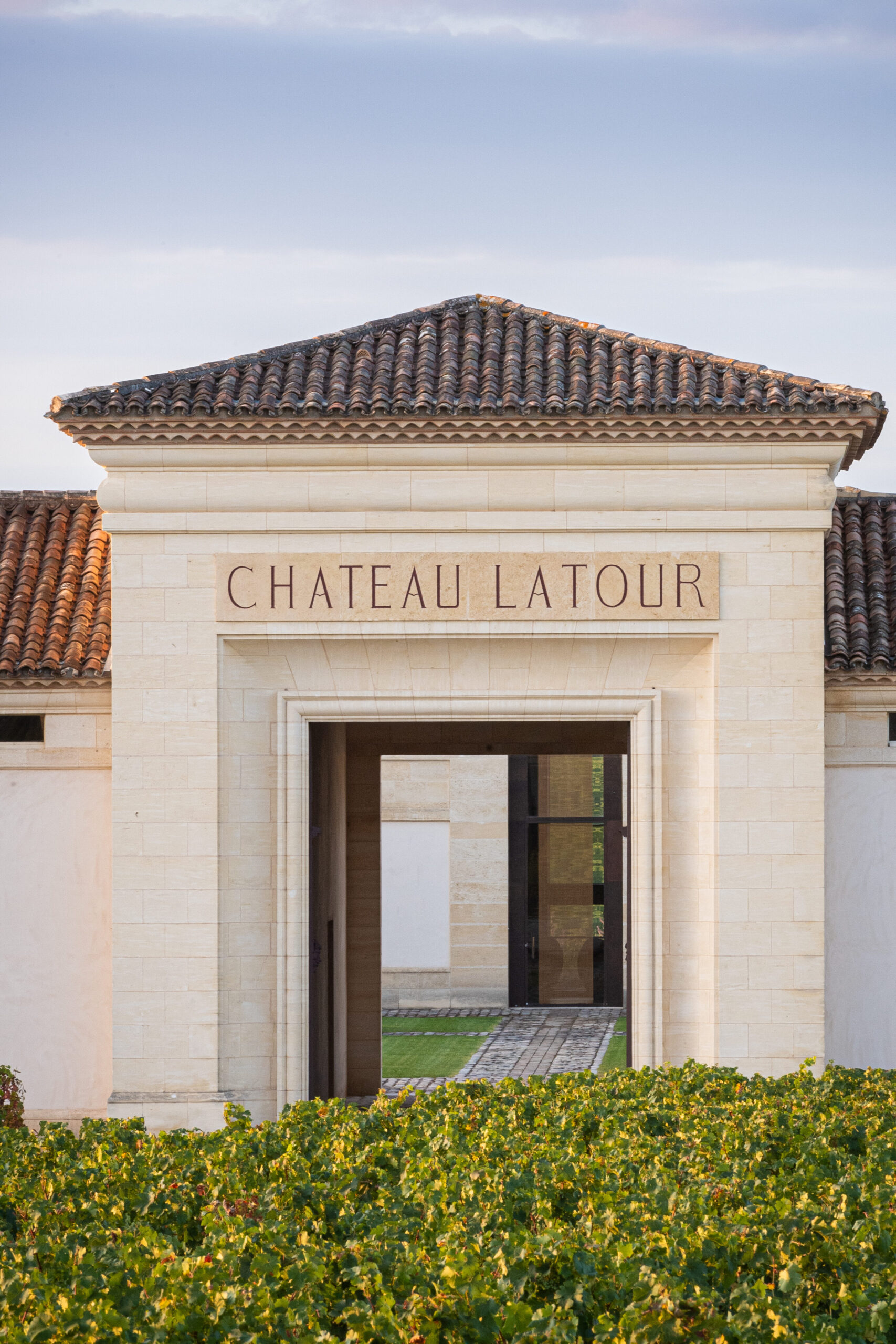
Bordeaux wines enjoy a global reputation for excellence, consistently ranking among the world's most sought-after and celebrated vintages. This esteemed status is a testament to a unique confluence of factors: exceptional terroir, a rich historical legacy, and an unwavering commitment to quality. From the iconic Cabernet Sauvignon blends of Médoc to the elegant Merlots of Saint-Émilion, Bordeaux wines captivate connoisseurs worldwide with their complex aromas, refined tannins, and remarkable aging potential. Renowned wine critics, including Jane Anson, who herself resides in Bordeaux, James Suckling, Jancis Robinson and Neal Martin, dedicate significant time and energy to evaluating these wines, consistently placing them at the pinnacle of their respective categories. In this article, we delve deeper into the secrets behind Bordeaux's dominance, drawing upon insights from these esteemed critics while sharing personal anecdotes and expert guidance from the Decanter Tours team.
Bordeaux wines are renowned for their distinctive flavor profiles, characterized by a captivating interplay of dark fruit notes, complex tannins, and a well-balanced structure. Cabernet Sauvignon, a dominant grape variety, imparts flavors of blackcurrant, cassis, and sometimes even a touch of graphite. Merlot contributes notes of strawberry, raspberry or even plum or cherry. These fruit flavors are often interwoven with nuances of cedar, tobacco, and leather, which develop as the wines age. Tannins, a key characteristic of Bordeaux, provide structure and a firm grip on the palate, evolving over time into a more refined and velvety texture. The interplay of acidity and tannin creates a sense of balance and tension, allowing the wine to age gracefully for decades. As Bordeaux wines mature, they develop greater complexity, with the fruit flavors evolving into more subtle nuances such as mushroom and even truffle or forest floor and earthy notes. The tannins soften over time, resulting in a harmonious and unforgettable drinking experience.
Alcohol also plays a significant role in the flavor profile. Bordeaux wines typically fall within the 12-14% alcohol by volume (ABV) range, while some Californian wines can reach upwards of 16%. This difference in alcohol content significantly impacts the flavor profile.
Higher alcohol levels in wine can:
In contrast, the generally lower alcohol levels we often find in Bordeaux wines tend to:
One of my most unforgettable moments of my wine tasting experiences in Bordeaux occurred during a dinner at a friend's classified growth château in Saint-Émilion. Nestled on the prime limestone plateau, this classified growth estate held a bottle of extraordinary significance.
Our host, with a twinkle in his eye, revealed that this 1943 vintage was a testament to the resilience of the human spirit, crafted by women while the men were away at war. As he carefully uncorked the bottle, I could almost feel the weight of history. The wine, although it had significantly diminished by ullage, (natural evaporation in the bottle), offered a captivating aroma of earth and spice, a far cry from the vibrant fruit notes of its youth. The alcohol level was also significantly reduced. Sadly but not surprisingly, the wine succumbed to maderization within minutes, a poignant reminder of its fragile nature. Yet, this fleeting encounter with a wartime vintage, a living organism that had weathered the storms of history, profoundly impacted me, proving that every bottle of wine carries a unique story and reflects the era in which it was born.
Not all of Bordeaux wines are made to stand the test of time however. Wines which favor Merlot tend to be drunk younger and Cabernet Sauvignon driven wines are more likely to age 50 years or more.
The most frequent question we get is about terroir. What exactly is terroir and why is it so important for Bordeaux wines? Terroir is a French term that encompasses all the environmental factors that influence the taste and character of a wine. This includes climate, soil, topography, and even the surrounding ecosystem. Some even add to that the human factor of pruning techniques and how the vintner treats the vines.
Bordeaux's Terroir:
Bordeaux's diverse terroir, encompassing climate, soil, and topography, plays a crucial role in shaping the unique character of its wines. The interplay of these factors results in a wide range of styles, from the powerful Cabernet Sauvignon-dominated wines of the Left Bank to the more approachable Merlot-based wines of the Right Bank. But never forget the vast majority of our wines in Bordeaux are blends.
Bordeaux: A Legacy of Winemaking Excellence
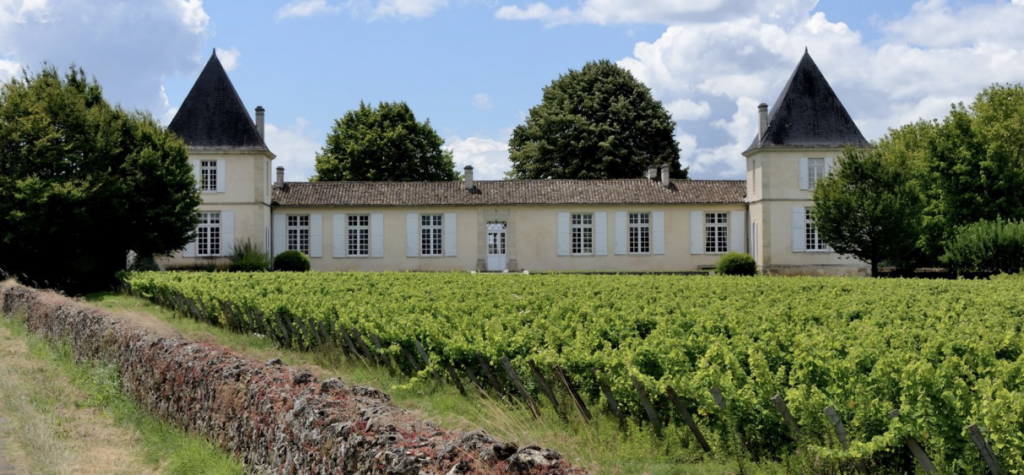
Bordeaux boasts a rich winemaking history dating back to Roman times. While early cultivation was limited largely to local consumption, the marriage of Eleanor of Aquitaine to Henry Plantagenet in the 12th century catapulted Bordeaux wines onto the world stage. For centuries, Bordeaux dominated English wine consumption, solidifying its reputation as a global powerhouse.
The region's fortunes have seen ups and downs, from the devastating impact of the Hundred Years' War in the 14th & 15th centuries, to the phylloxera epidemic in the 19th century. However, Bordeaux has consistently demonstrated resilience and innovation. The establishment of the 1855 Classification of Grands Crus in 1855 marked a significant milestone, solidifying the region's hierarchy and guiding collectors and connoisseurs. Bordeaux was the first to create a hierarchy for wines.
Modern Bordeaux winemaking is a testament to centuries of expertise and meticulous craftsmanship. From the careful selection of grapes and meticulous vineyard management to state-of-the-art winemaking techniques, every step of the process is meticulously considered. And Bordeaux is a center for research and development in the sector.
While the 20th century brought its share of challenges, including economic downturns and evolving consumer tastes, Bordeaux has continually adapted. The rise of influential wine critics and the emergence of "second wines" have further refined the region's offerings. Today, Bordeaux remains a global benchmark for quality and continues to captivate wine lovers worldwide with its diverse range of styles and its enduring legacy.
A prime example of unwavering commitment to excellence can be seen in Château d'Yquem, the renowned Sauternes producer owned by LVMH. Such is their dedication to producing wines of exceptional quality that in years when the grapes do not meet their exacting standards, no sweet wine is produced at all.
Experimentation is rife within the Bordeaux vat houses in the quest for making high quality wines. Les Carmes Haut Brion's wine maker frequently conducts wine making trials. For example recently we caught him using an inflated donut filled with air which pushes the cap (the grape skins) back down into the wine during fermentation, for a softer, subtler infusion of the aromas, tanins and flavors in the wine.
Bordeaux, the legendary wine region, is known for its tradition. But don't let that fool you! Many chateaux are embracing innovation, experimenting with alternative vessels like amphorae and wine globes.
Amphorae: These ancient clay pots are making a comeback in Bordeaux. Their porous nature allows for gentle oxygenation, adding intriguing earthy notes to the wine. Some chateaux are even using amphorae for partial aging or the alcoholic fermentation, combining tradition with a touch of the unexpected.

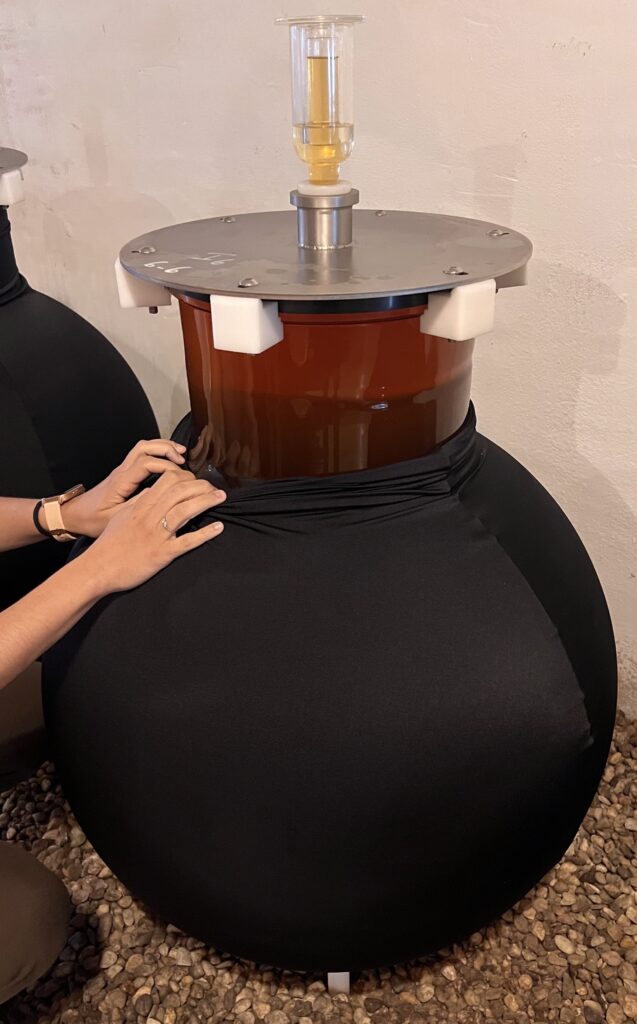
Wine Globes:
These spherical glass vessels offer a pure expression of the grapes and terroir. Free from the influence of oak, wines aged in globes can showcase the unique fresh and fruity character of Bordeaux's diverse terroirs. Chateau Climens in Sauternes is one good example.
A Bordeaux Renaissance:
These experiments are breathing new life into Bordeaux wines. By exploring alternative vessels, winemakers are pushing boundaries and creating wines that are both innovative and deeply rooted in the region's heritage.
A personal wine story from our best Bordeaux wine guide, Veronica
There are wine tastings, and then there are wine experiences that transcend the ordinary, becoming cherished memories etched in time. Our recent visit to Château Langoa and Léoville Barton in Saint-Julien proved to be precisely such an occasion, where the intersection of tradition, family heritage, and exceptional wines created an unforgettable day.
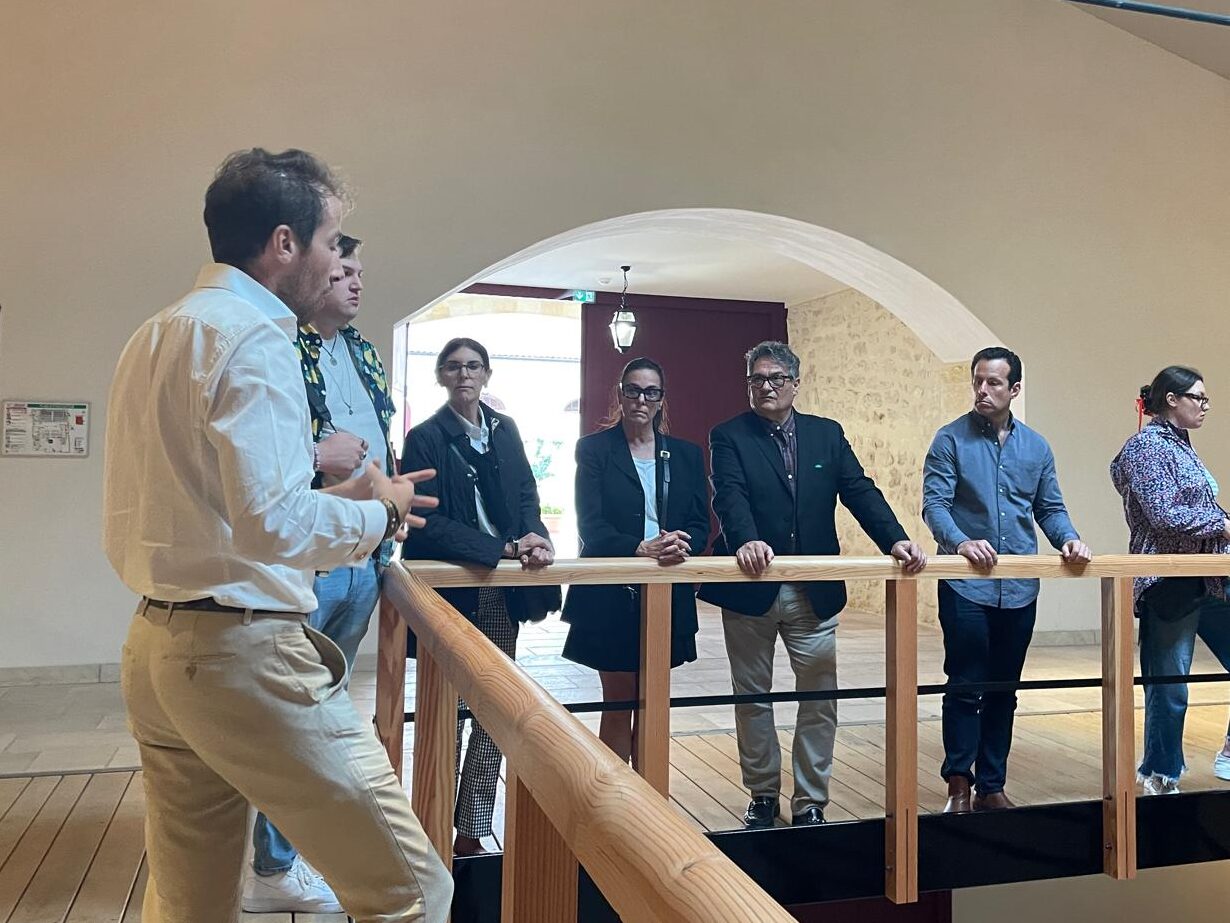
Our small group of American wine enthusiasts, fresh from a successful Nashville Wine Auction bid, found our group in the capable hands of Damien Sartorious, the ninth-generation steward of these prestigious second-growth properties. What followed was not merely a tour, but an intimate glimpse into the soul of Bordeaux winemaking.

The journey began unconventionally, with Damien whisking us away in a 1970s Land Rover for a safari-style exploration of the Saint-Julien vineyards. As we traversed the terrain, the landscape unfolded like chapters in a story, each turn revealing new secrets. Damien pointed out the woods where he played as a child, bringing a personal touch to the grand tapestry of the estate's history. The varying terroirs revealed themselves beneath our feet – from gravelly slopes to sandy patches and distinct terraces – each contributing its unique character to the wines we would later taste.
The contrast between old and new at the estate was striking yet harmonious. In the vineyards, we witnessed the ancient practice of leaf thinning, performed meticulously by hand with homemade machetes – a testament to time-honored traditions. Yet, just steps away stood the state-of-the-art cellar, its modern efficiency thoughtfully cloaked in natural materials and wood, maintaining a respectful dialogue between past and present.
A truly privileged moment arrived when we were invited into the private cellar, its bottles wearing their dust and dampness like badges of honor. Here, each guest was granted the rare opportunity to select a bottle from the family's private reserve – a gesture that spoke volumes about the Barton family's legendary hospitality.
The culmination of our visit took place in the château's private gardens, where champagne and aperitifs set the stage for what was to follow. The long lunch that ensued with Damien was a masterclass in Bordeaux wines, but more importantly, it was a sharing of his personal stories that made the exceptional wines feel like supporting characters in a larger narrative.
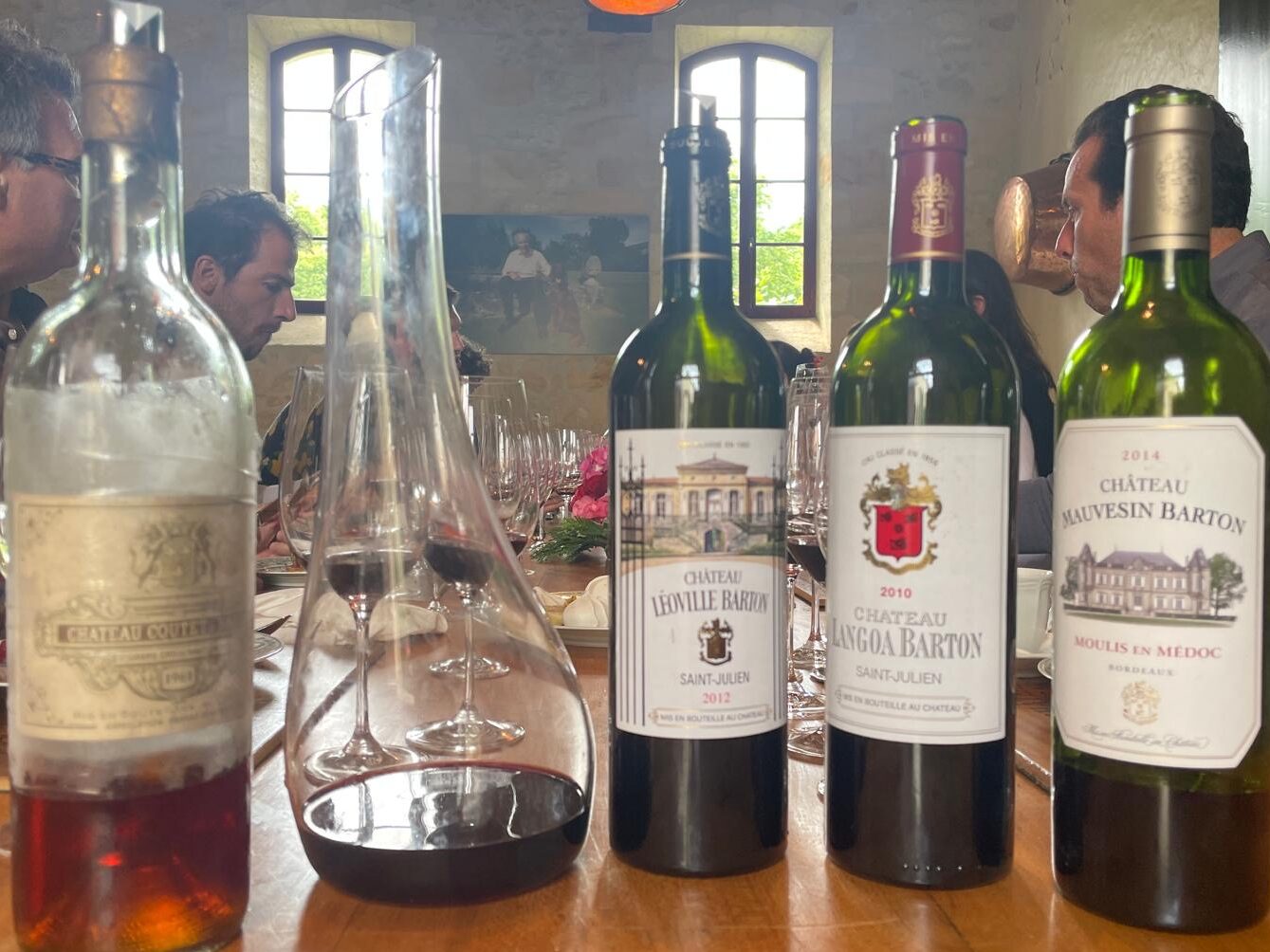
The wine lineup was nothing short of extraordinary: we traveled through time with Mauvesin Barton 2014, Langoa Barton 2010, and Léoville Barton 2012. A treasured Langoa Barton 2000 from the cellar selection added historical depth, while a magnificent 1961 Château Coutet Sauternes provided a fitting finale to our tasting journey.
What struck us most profoundly was not just the excellence of the wines – though they were indeed outstanding – but the authentic connection to place and history that permeated every aspect of our visit. Through Damien's eyes, we saw not just a prestigious Bordeaux estate, but a living heritage, carefully preserved and thoughtfully evolved through nine generations of stewardship.
As we reluctantly bid farewell to Château Langoa and Léoville Barton, we carried with us more than memories of exceptional wines. We had experienced something increasingly rare in today's world: a genuine encounter with authenticity, where tradition, innovation, and family legacy blend as seamlessly as the finest Bordeaux cuvées.
Through our many experiences like this one, its easy to see why Bordeaux holds a special place in our hearts and why we have made it our life's work at Decanter Tours recommending it to others.
Bordeaux reigns supreme in the world of wine due to a compelling blend of factors. Centuries of geological evolution have gifted Bordeaux with a unique tapestry of soils, from the gravelly slopes of the Médoc to the limestone-rich hills of Saint-Émilion. This diverse terroir cultivates a remarkable range of flavors and aromas in the wines. Bordeaux boasts a centuries-old winemaking tradition, passed down through generations of skilled vignerons. This deep-rooted knowledge, combined with constant innovation, ensures that each vintage reflects the unique character of the land. From the structured power of Cabernet Sauvignon-dominant blends to the elegant finesse of Merlot-driven wines, Bordeaux offers a symphony of tastes. Whether you prefer the bold, fruit-forward styles of the Right Bank or the structured elegance of the Left Bank, or the sweet wines of Sauternes, Bordeaux has something to tantalize every palate.
At Decanter Tours, we've been privileged to share the magic of Bordeaux with discerning wine enthusiasts since 2009. We've explored the most prestigious estates, tasted legendary vintages, and witnessed firsthand the dedication and artistry that go into crafting these exceptional wines. This profound connection with Bordeaux fuels our passion for introducing others to the wonders of this legendary region.
We invite you to embark on your own Bordeaux adventure. Whether you're a seasoned oenophile or just beginning your wine journey, Decanter Tours offers a range of experiences tailored to your interests. Join us for a captivating wine tasting, an unforgettable vineyard tour, or an immersive journey into the heart of this legendary region.
Discover the magic of Bordeaux for yourself. Contact us today to book your unforgettable wine experience.
Bordeaux wine stands among the world's finest due to its perfect combination of terroir, tradition, and technique. The region's gravelly soils, maritime climate, and centuries-old winemaking expertise create wines of exceptional complexity and aging potential. The strict classification system established in 1855 and those established since, also ensure consistent quality, with prestigious châteaux maintaining exacting standards that have defined excellence in winemaking for generations.
Bordeaux's uniqueness lies in its distinctive blend-focused approach, particularly with Cabernet Sauvignon and Merlot for red wines. The region's location between two rivers, the Atlantic Ocean and the Landes forest, creates diverse microclimates, while its historic château system combines wine production with architectural heritage and beauty. Additionally, Bordeaux's classification system and en primeur (futures) trading model have set global standards for wine commerce and collection.
Start by identifying which appellation of Bordeaux interests you - Left Bank appellations for Cabernet-dominant blends with more tannins, or Right Bank for softer, Merlot-based wines. Consider the vintage, as quality varies by year, and look for smaller châteaux from good years for better value. For beginners, try wines from Bordeaux Supérieur, the Côtes appellations or Cru Bourgeois classifications, which offer excellent quality at more accessible prices. Top tip: wines from lesser known appellations like Fronsac or Castillon often provide outstanding value while maintaining Bordeaux's signature style.
Experience the world of Bordeaux wine firsthand with our expert-guided tours.
Bordeaux is one of the world’s most iconic wine regions, known for its prestigious châteaux, timeless wines, and breathtaking landscapes. But when visiting Bordeaux, is hiring a wine tour guide necessary, or can you enjoy the experience on your own? Let’s explore why a Bordeaux wine tour guide can significantly enhance your wine adventure.
At Decanter Tours, we understand that you want to get the most out of your Bordeaux wine trip. Our expert wine guides ensure that every tour becomes a deep dive into the art of winemaking, the history of Bordeaux, and, most importantly, the wines themselves. Without a guide, navigating Bordeaux’s sprawling wine region and understanding its vast selection of wines can be overwhelming. A guide offers insider access to exclusive wineries, personalized tours, and a curated experience, making your visit educational, enjoyable, and stress-free. Whether it’s your first visit or your tenth, a wine tour guide helps you appreciate Bordeaux wines on a deeper level, focusing not only on the tasting but also on the stories behind each bottle.
Our guides at Decanter Tours stand out due to their passion for wine and commitment to sharing that passion with every guest. Each guide is a seasoned expert in the Bordeaux wine industry, holding certifications from prestigious institutions such as WSET (Wine & Spirit Education Trust) and Bordeaux’s Institute of Vine and Wine Science. What sets our guides apart is their personal experience in the world of wine. Veronica, one of our lead guides, holds multiple certifications, including WSET Level 4, a Wine Marketing Diploma from New Zealand, and the coveted certification from the Court of Master Sommeliers. Her knowledge extends beyond Bordeaux as she teaches young hospitality students at the renowned Vatel hotel school. This deep expertise ensures that our guests not only enjoy a tour but gain an education in fine wine.
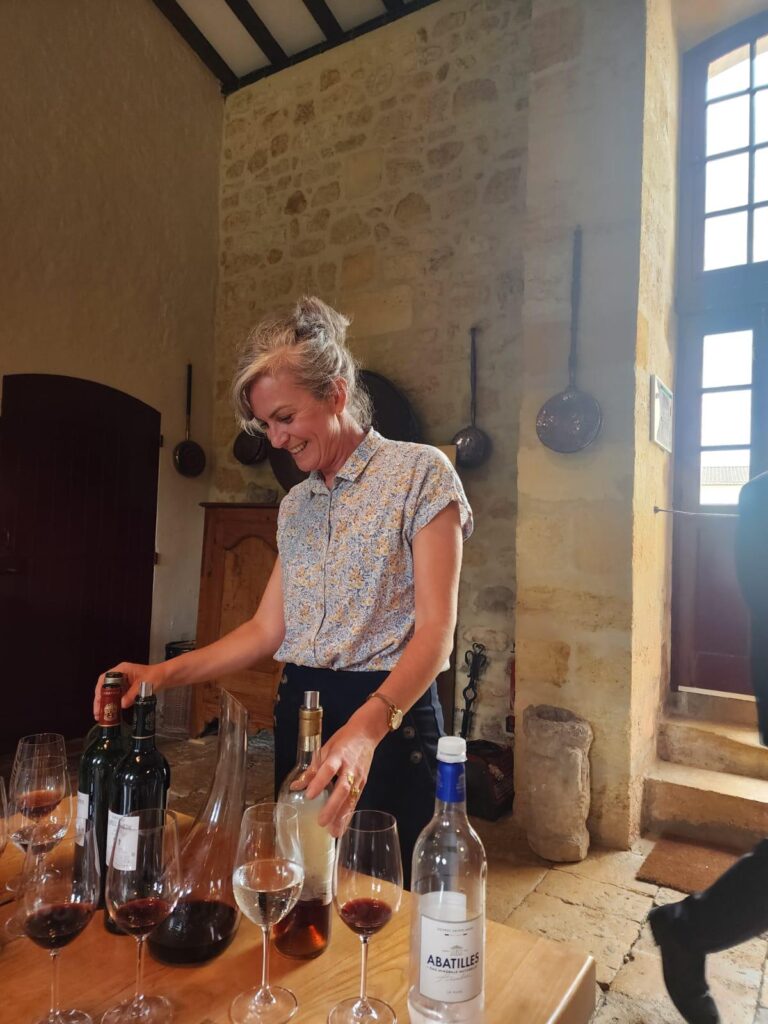
Whether you're a novice or an enthusiast, here are five compelling reasons why hiring a Bordeaux wine tour guide is essential for maximizing your experience:
A skilled wine guide helps you articulate what you're tasting. With their guidance, you'll learn how to evaluate wines more precisely, identifying flavor profiles, textures, and structures that you might otherwise miss. From the balance of tannins to the subtleties of aromas, our guides teach you the nuances that make Bordeaux wines exceptional.
Bordeaux’s wines can be complex, with layers of history, tradition, and unique winemaking practices. A professional guide will explain everything, from how the region's famous terroir impacts the flavor profile of the wines to why certain grapes thrive in particular climates. Whether it's explaining malolactic fermentation or the significance of appellations like Pauillac or Saint-Émilion, our guides provide a wealth of knowledge that makes your tour unforgettable.
With the help of a guide, you won’t need to guess which wine to purchase or enjoy. A professional guide tailors recommendations to your taste, ensuring that you find wines you'll love. Additionally, they introduce you to hidden gems that might not be well-known but are perfect for your palate.
Wine jargon can be intimidating, but a good guide will break it down for you in easy-to-understand terms. Whether it's understanding the difference between oaked and unoaked wines or what terms like “terroir” and “vintage” truly mean, your guide will demystify the language, making wine more approachable and enjoyable.
One of the marks of a great wine guide is knowing when to offer expert insights and when to let you savor the moment. Our guides strike the perfect balance between education and enjoyment, making sure you walk away with more knowledge while still appreciating the atmosphere, wine, and beauty of Bordeaux.
Don't just take our word for it, our customer reviews speak for themselves:
"Janice, [was] our tour guide for the day...to say Janice was amazing would be an understatement. Her knowledge of the Bordeaux region, wine and Chateau's in the area was very impressive...we visited 2 different Chateau's that day and Janice could have given the tours as well as the representatives that greeted us at each Chateau. Of course the Bordeaux countryside, Chateau's, and wine were breathtaking but Janice just really made it that much better." Phil P. (Visited in April 2024)
A Bordeaux wine tour guide isn’t just a luxury—it’s an essential part of your wine journey. With the sheer number of wineries and vast wine selections, it’s easy to feel overwhelmed. A guide not only ensures you visit the right places but also tailors your experience to your level of interest, making sure you get the most out of your trip.
At Decanter Tours, we make sure your experience is more than just informative. Our guides create an immersive, unforgettable adventure that blends history, culture, and wine in perfect harmony. From discovering the region's hidden treasures to enjoying some of the world’s finest wines, you’ll leave Bordeaux with cherished memories and a deeper understanding of its legendary wines.
With wine tours starting at just 300€ per day, the investment in a guide is small compared to the lasting value and insight you’ll gain. Contact us today to start planning your Bordeaux wine adventure!

Experience the finest private wine tours in Bordeaux and beyond. With over 20 years of expertise, we craft tailor-made wine journeys to iconic regions like Médoc, Saint-Émilion, Burgundy, and Champagne. Explore exclusive chateaux with expert guides and seamless planning for a truly unforgettable experience.